2010 Oslo Cruise
A Lovely Stroll Through Paris
Written by Rick Archer
March 2013
|
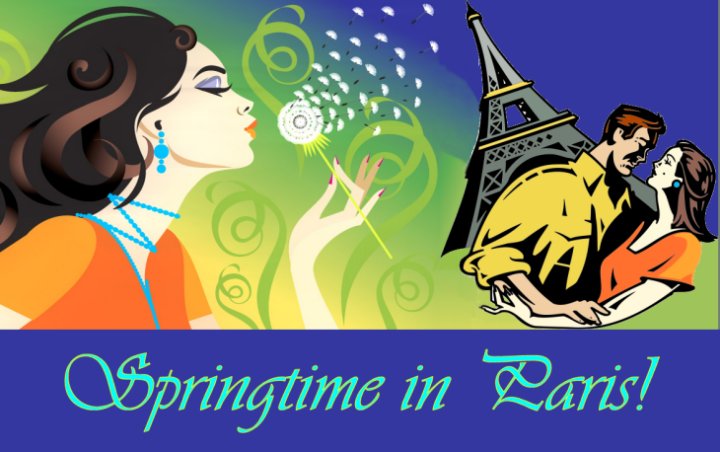 |

 |
Forward
Rick's Note:
I suppose it might seem a little odd to some people that I
am writing in 2013 about a visit that took place in May
2010. A casual glance at the calendar shows that our
Oslo cruise took place three years ago.
There are two
reasons for the delay. When we returned, I immediately threw all my energy
into writing my intense story about
D-Day.
As anyone
who has read my account of that visit knows, I was deeply
affected by my visit to Omaha Beach during this trip.
I was so moved by the experience that I spent the next two
months researching and writing my story. I am pleased to say
that I did a very good job.
As it turned out, that story is now widely acclaimed as one of the best stories
on the Internet to explain how the Americans
were able to turn an almost certain defeat into a remarkable
victory.
However, I was
so spent when I finished my story that I took a break from
writing. By the time
I finished my lengthy seven chapter story about D-Day, it
was time for our next cruise and I got distracted by the new
trip. When my writing bug returned, I wrote about the
next cruise instead. That's a shame because our 2010
Oslo Trip continues to be one of my three favorite cruise
trips.
Perhaps I can
use this story about Paris to help restart my engine and
finish the stories about Ireland and Scotland as well.
While I am at it, I suppose I should reveal the other reason
why I have hesitated writing about this visit.
The truth is
that our 2010 visit to Paris frustrated me so much that I
did not want to revisit this day. Writing about it was sure
to aggravate me again.
This was the first visit to Paris for both Marla and me.
As you will read, it was a largely unsatisfying day for us. Although Marla
and I thoroughly enjoyed what we were able to see, we just
didn't get to see enough.
I probably shouldn't
say this, but a cruise trip is not the best way to
appreciate Paris. After docking at Le Havre 95 miles
west of Paris, we wasted four hours of the day traveling by bus trip to
and from Paris.
Consequently we
had only five very brief hours to appreciate Paris. Considering
that the city turned out to be just as spectacular as
advertised, this was hardly enough time to do anything more
than whet our thirst.
For example, we
didn't visit the Louvre Museum, very high on our list.
We spent only five minutes on the famed
Champs-Élysées. We didn't get to see the Arc d'Triomphe. We didn't get to
visit the top of the
Eiffel Tower. We didn't see Versailles. We
didn't see Notre Dame. We didn't see Île de la Cité. We didn't
take a river boat ride down the Seine River. We didn't
see any of the lush city parks. Hell, it felt like we didn't see
anything!!
All we did was
scratch the surface. What little we did see suggested
that Paris might indeed be the most beautiful city in the world.
I can safely say that all our brief visit to Paris
accomplished was to awaken a burning desire to return some
day and see more!!
|
| |
|
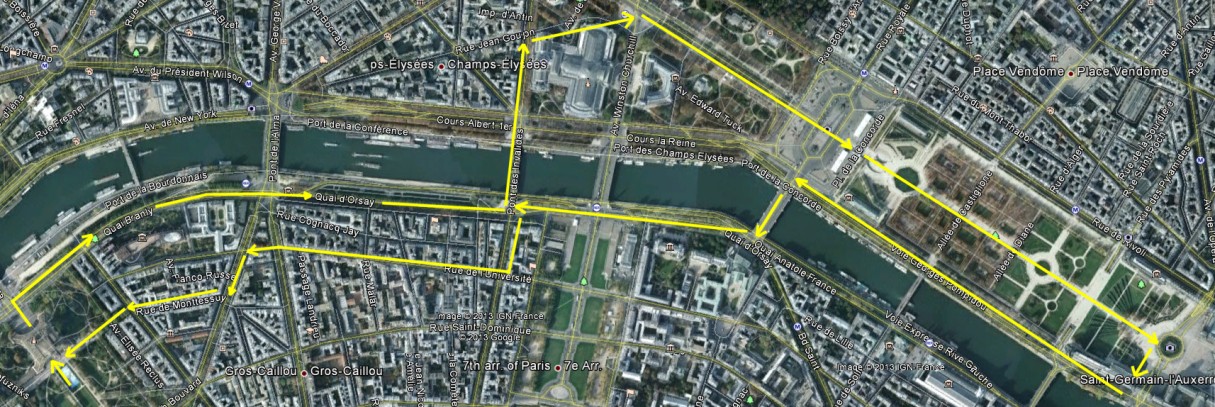
|
A
Four
Mile Walk
Through Paris
Our bus dropped us off right at the curb of the
Eiffel Tower. That actually made a lot of sense.
If we hailed a cab at the end of the day, we could just say
"Eiffel Tower". Better yet, no matter where we
wandered on our long walk, we were never in danger of
getting lost with that monster tower looming above.
I had to laugh.
This was the best landmark since the Cayman Islands.
The highest point in the Caymans is 50 feet. As a
result, our giant cruise ship can be seen from wherever we
go.
Marla and I had
a simple plan. With just five hours, we would walk
in one direction for 2 hours, eat lunch, then head back.
As it turned out, the famous Seine River that winds through
the very heart of Paris was nearby. We headed out
along the banks of this historic river. It was
literally "Springtime in Paris". The lovely pink
cherry blossom trees were in full bloom.
As for poor
Marla, this was perhaps her last good smile of the day.
She was mysteriously tired from the outset. As it turned
out, Marla was suffering from the onset of the awful
Norovirus that plagued our entire ship. Indeed, one of
her major goals for the day was to sample French coffee and
croissants. No such luck. By the time we sat down for lunch, she had
a serious stomach ache that prevented her from enjoying her
meal.
This Norovirus
is pretty serious stuff. Although I was spared,
several people in our group caught it. It lasts for 24 hours
and knocks people on their butts. I wrote an extensive
article on our unpleasant Norovirus
experience.
Marla's strength
declined steadily during our walk. Marla was in so much pain that she was forced to stay
in her room the next day. It drove her nuts that she
would have to miss our trip to Omaha Beach, but she was in
no shape to leave the cabin.
|
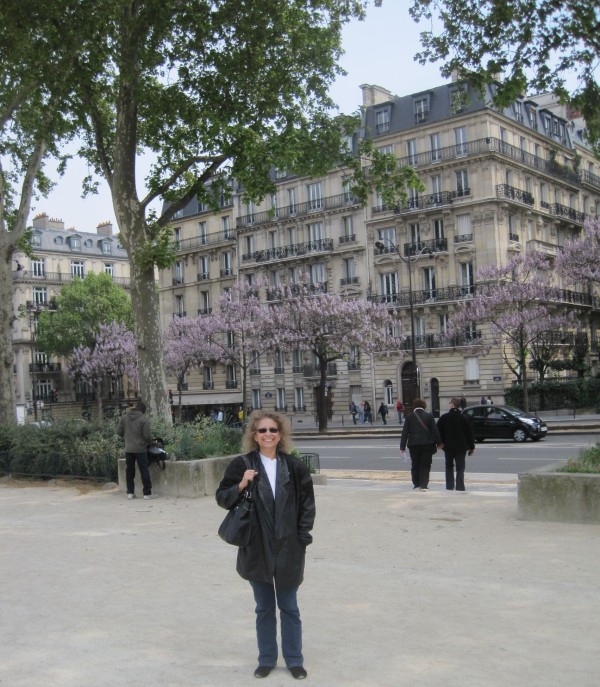 |
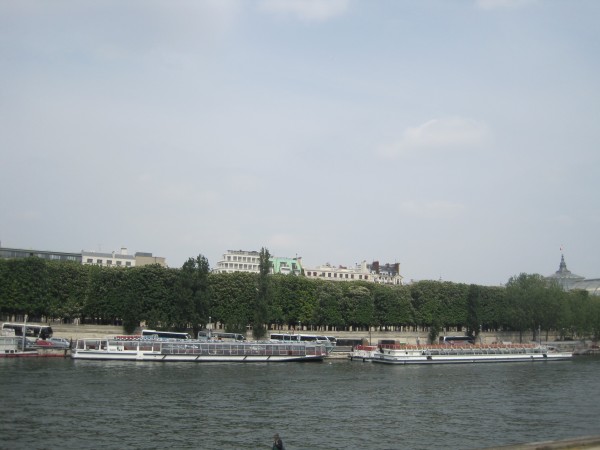
The Seine
meanders on a 20 mile trip throughout Paris. Marla
and I had debated long and hard about taking a river cruise
along the Seine. What a lovely way to see all the
famous sights of Paris! Ultimately we chose to take a
long walk instead, but we were full of regret all day long.
It didn't help seeing these longboats shoot by on a regular
basis. Nor did it help when our friends Bill and
Sharon Shaw raved about how much fun they had on their Seine River experience later
that evening.
|
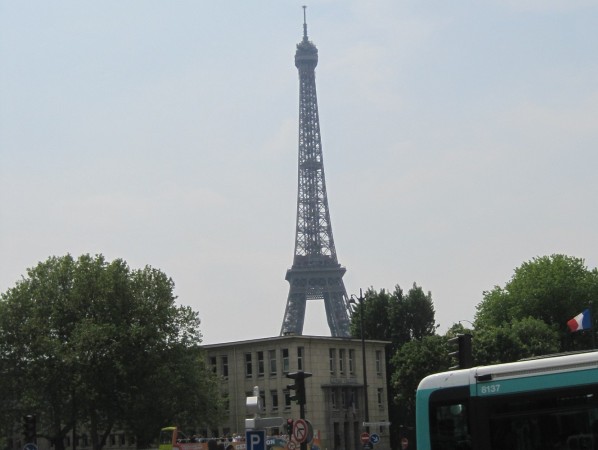
Wherever we
went, the Eiffel Tower was impossible to miss. I had
no idea how immense this structure is. Some people
call it the "Eye-ful Tower" while others call it the "Aw-ful
Tower". Considering how
much fame this tower has brought to the city, it is hard to
believe the structure was bitterly criticized during its
construction. French writer Guy de Maupassant was said
to eat lunch in the Tower's restaurant every day. When asked
why, he answered that it was the only place in Paris where he
didn't have to look at the damn structure.
|
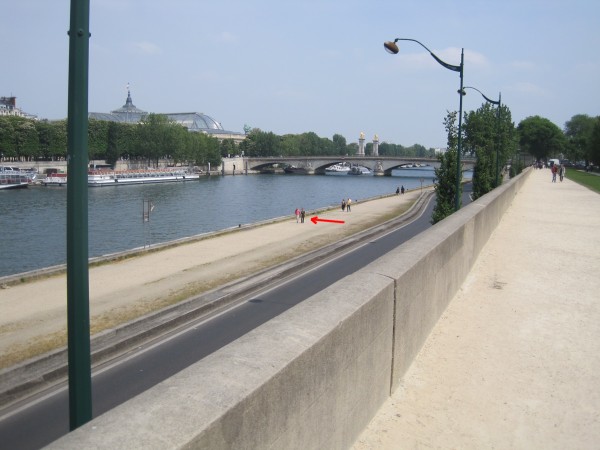
With Paris being
labeled the world's most romantic city, I decided to see if
the city lived up to its reputation. I made a project out
of snapping photos of any romance I might notice
during our journey. For example, in this picture, I have
identified my very first target of the day.
|
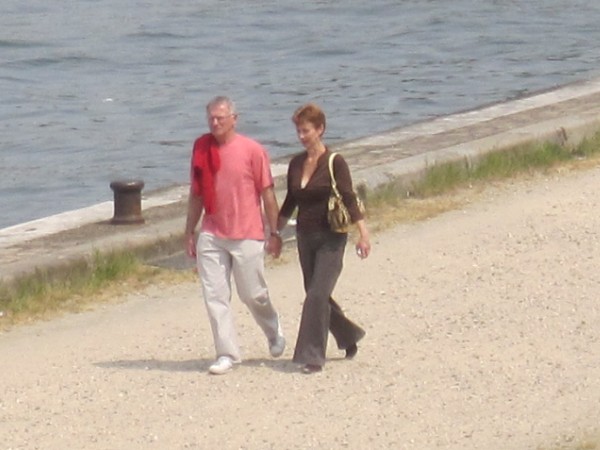
Well, there they
are, today's first romantic couple. Will there be any
others? We will just have to find out. Notice
the iron plug in the background. This entire area is a pier known
as a "quai". Various small boats use that iron
plug to tie their ropes as a way to secure their vessels.
|
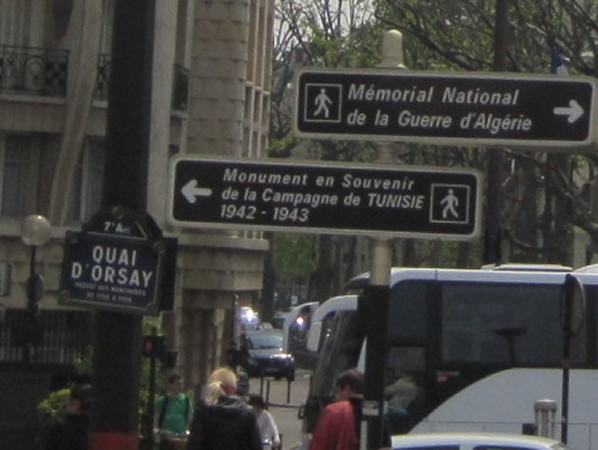
The Quai d’Orsay
is part of the famed Left Bank of the Seine.
The Quai has historically played an important role in French
art as a location to which many artists came to paint along
the banks of the river Seine.
The French
word "Quai" means pier or wharf. Long ago, this was
the spot where food from the countryside was delivered by
boat to the
heart of Paris. The same street becomes the Quai Anatole
France to the east of the Palais Bourbon and the Quai Branly
to the west.
The French Ministry of Foreign Affairs is located on the
Quai d'Orsay. Thus the ministry is often called the "Quai
d'Orsay" by metonymy. By the way, I had to look up
"metonymy".
"The
substitution of the name of an attribute or adjunct for
that of the thing meant, for example suit
for business executive."
|
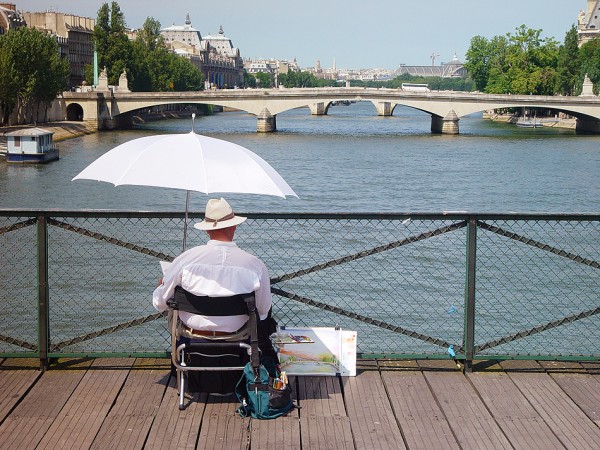
La Rive Gauche
is French for The Left Bank. Where Marla and I were
walking on the southern bank of the river Seine was "The
Left Bank" of worldwide fame.
"Rive Gauche" or "Left Bank" generally refers to the Paris
of the Roaring Twenties. During this era, Paris was a
beehive of artists, writers and
philosophers. Pablo Picasso, F. Scott Fitzgerald, Arthur Rimbaud, Paul
Verlaine, Henri Matisse, Jean-Paul Sartre, Ernest Hemingway,
Gertrude Stein and dozens of other members of the great
artistic community gathered at Montparnasse, located
one mile south of the Seine.
These artists
were featured in the terrific 2011 Woody Allen movie
Midnight in Paris. Our own Greenwich Village in
New York City served as a similar meeting place in the
Sixties. Apparently great minds enjoy seeking the
company of other geniuses. Today the phrase
"Left Bank" implies a sense of bohemianism, counterculture and
creativity.
|
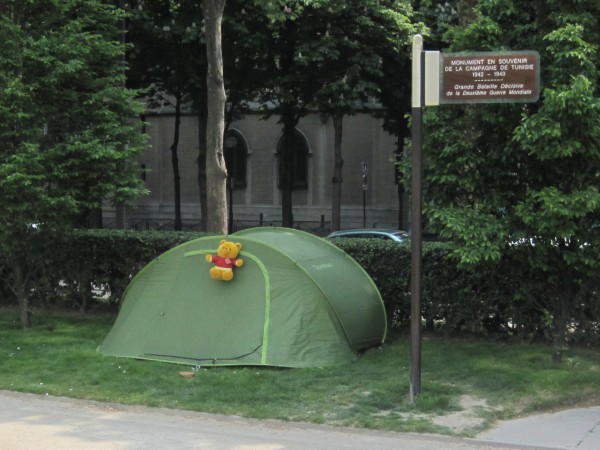
Aha, a teddy
bear. As everyone knows, the cost of a hotel in Paris
can be exorbitant. Here someone seems to have found a
way to beat the high prices.
|
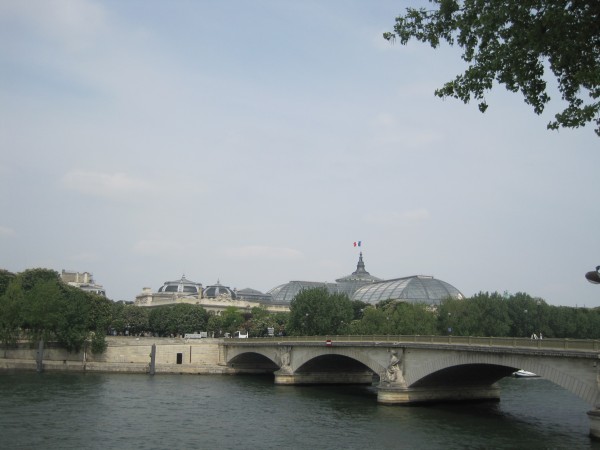
That structure
is the Grand Palace, an exhibition hall and museum complex
located at the Champs-Élysées. Built in 1900, it has
seen major art exhibits, riding competitions, and technology
conferences staged here. The bridge is known as "Pont
des Invalides".
|
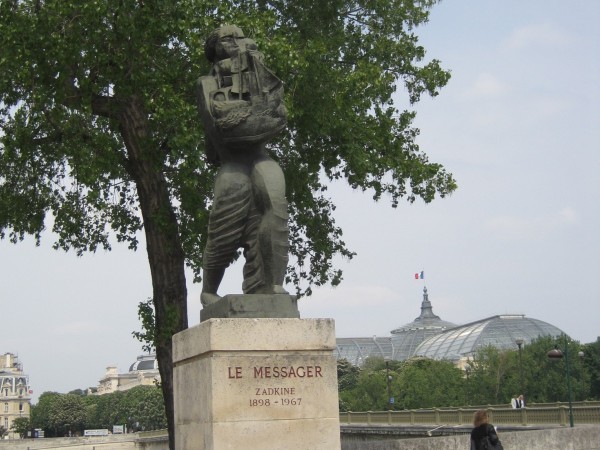
Located at the
Pont des Invalides along the Quai d'Orsay, you cannot
miss this impressive bronze sculpture of the artist Zadkine.
It was created to decorate the
Pavillon des Bois Exotiques of the Exposition Internationale
of 1937, which was also situated on this
spot on the Quai d'Orsay.
|
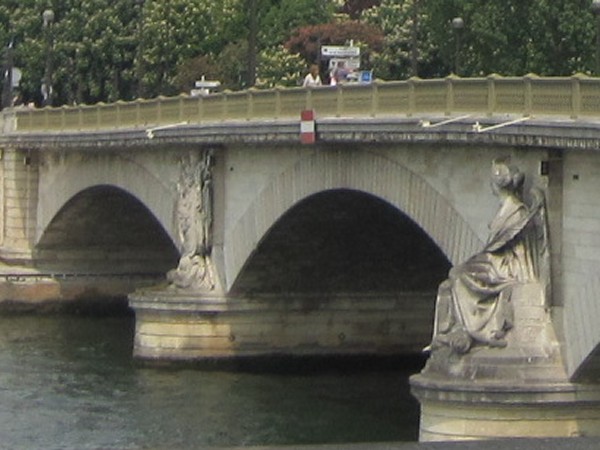
Each bridge
along the Seine is decorated with beautiful sculptures.
Wherever Marla and I went, we were greeted with tasteful
objects of art such as these. I love Houston, but I
doubt I will ever see the day when our city decides to
replace the giant ugly billboards with tree-lined vistas and
statues.
|
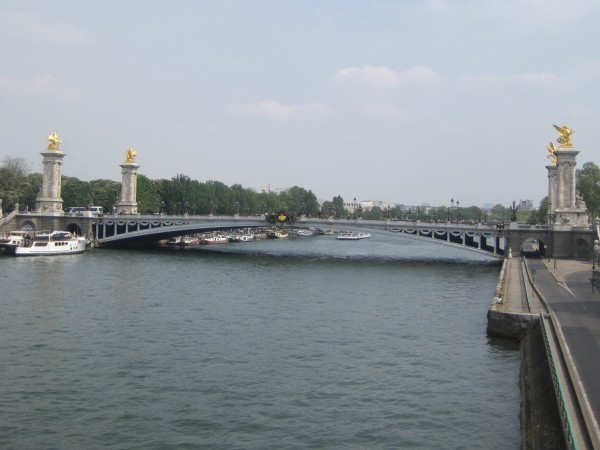
Pont Alexandre III is widely
regarded as the most ornate,
extravagant bridge in Paris. Those golden
statues can be seen
at either end. The bridge is named
after Tsar Alexander III at the conclusion of the
Franco-Russian Alliance in 1892.
|
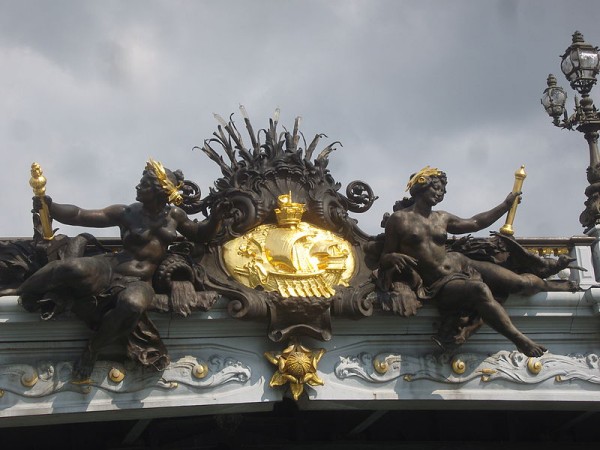
In the center of
the same bridge is this sculpture known as the "Nymphs of
the Seine".
Everywhere you go there are statues. Walking through Paris is like walking through an open air
museum.
|
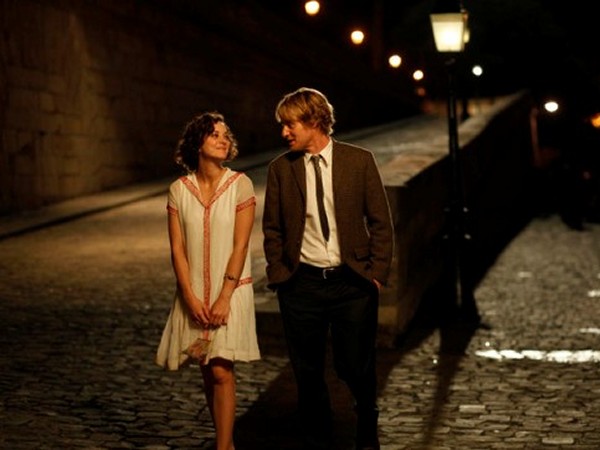
Midnight in Paris is a 2011
romantic comedy film written and directed by Woody Allen.
It won an Oscar for Best Original
Screenplay, a much-deserved award in my opinion.
Taking place in Paris, the film follows Gil Pender, a
screenwriter who is forced to confront the shortcomings of
his relationship with his materialistic fiancée and their
divergent goals.
|
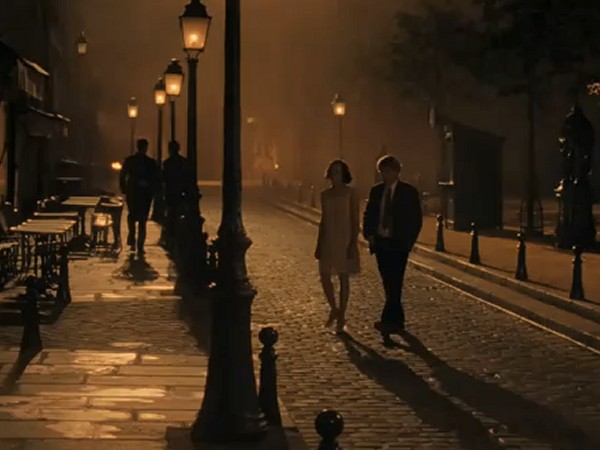
What makes the
movie so much fun is watching Paris in the 1920s come back
to life. Using a very amusing
fantasy theme, each night at
midnight the hero travels back in time to meet the key
literary and artistic figures of Paris in
the Twenties, an era he idolizes. Suddenly
we get to meet F. Scott Fitzgerald, Ernest Hemingway, &
Pablo Picasso. These scenes are magic!
|
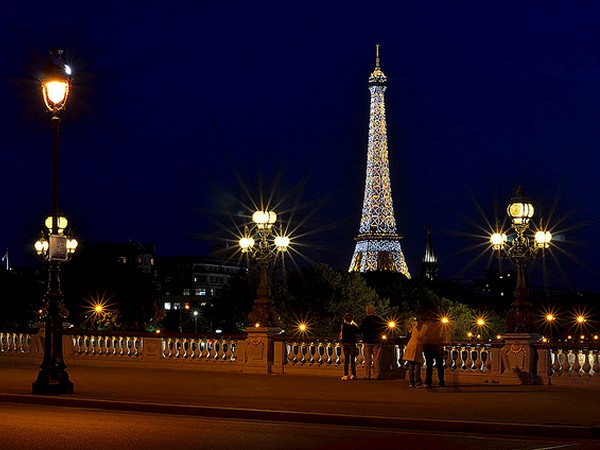
Several scenes
in Midnight in Paris were shot on Pont Alexander III.
Here is a picture from the middle of the movie that was shot on the
bridge.
|
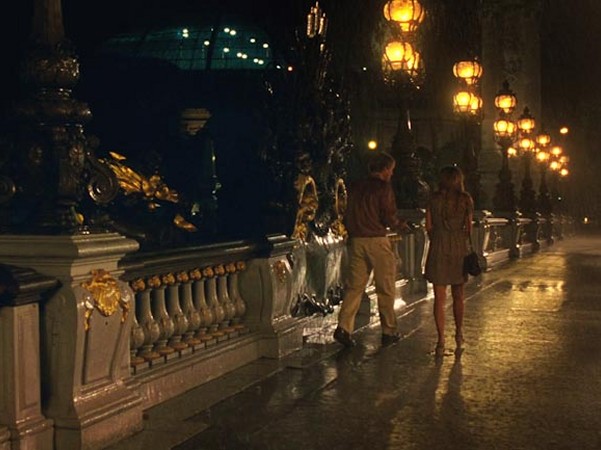
As you may have
guessed, "Pont" is French for "bridge". Here is a picture from the final scene
of Midnight in Paris that was shot on the same bridge.
|
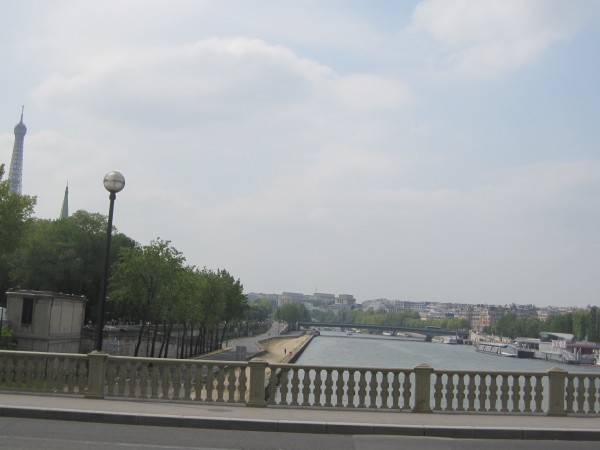
After all that
buildup about Pont Alexandre III, we crossed the
Seine at Pont des Invalides
instead. At the time I had
no idea we were skipping the more famous bridge. Oh
well. This bridge worked just fine. There's the
Eiffel Tower to the left and one of the
many riverboat terminals on
the right.
|
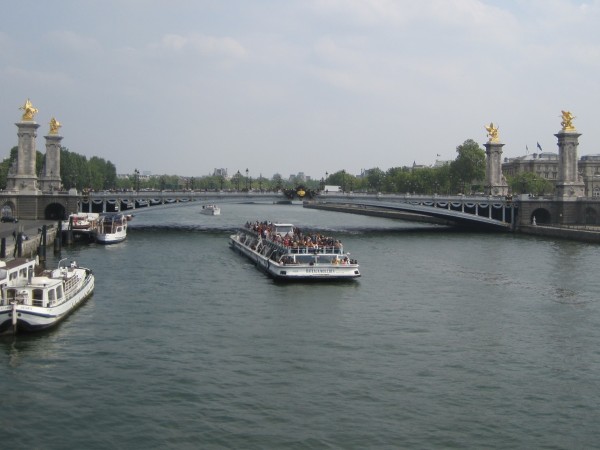
Speaking of
riverboats, I turned around to photograph the opposite
direction and saw one coming right at us. Everyone was
drinking wine and laughing with joy. I frowned
immediately. I was deeply suspicious they might be having more fun than me.
|
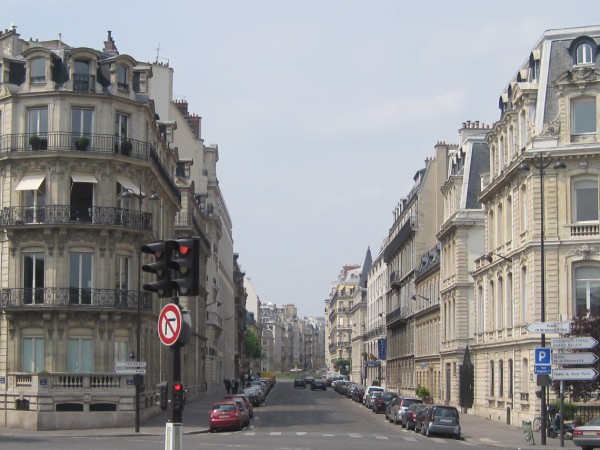
Now that we have
crossed Pont des Invalides, that is Rue Francois
zigzagging to the northwest.
|

That is Avenue
Franklin Delano Roosevelt straight ahead. We have
now finished a quarter of our walk.
|
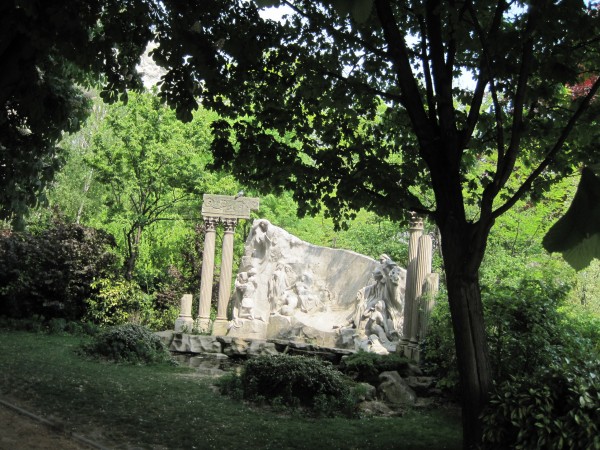
As we walked along
Avenue FDR, we
noticed a lovely park across the street.
|
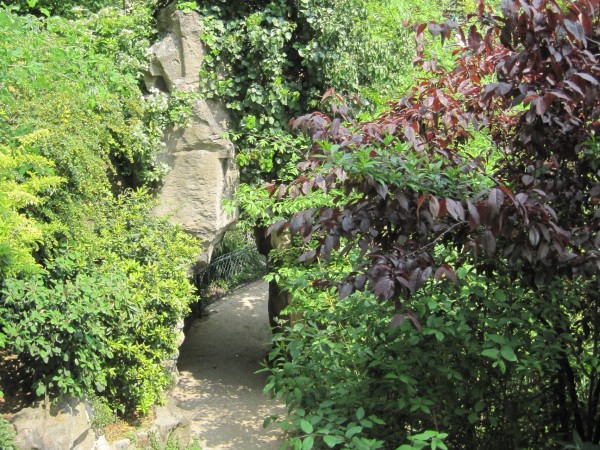
I was intrigued by the thick
shrubbery. What could be hiding in there, I wondered.
Curious, we investigated. That little walkway in the
picture led us to a lovely little bridge.
|
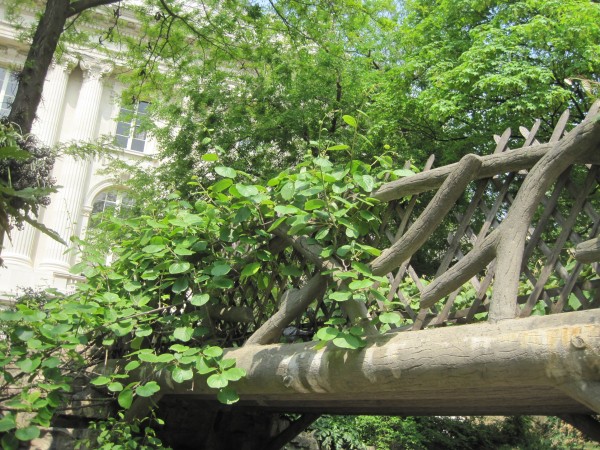
Is this just the
coolest little bridge in the world?? This park was
much too pretty.
|
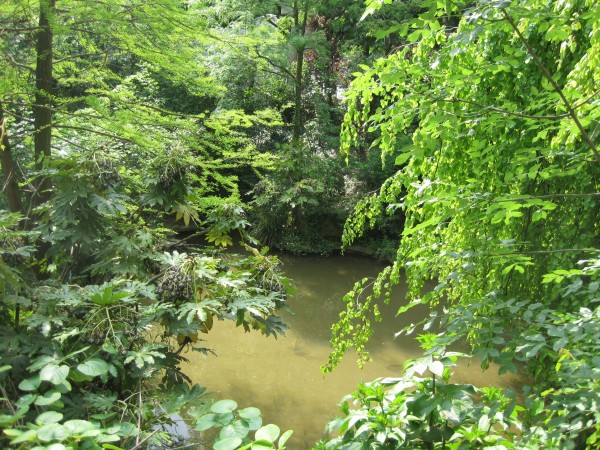
To my delight, we discovered this
lovely pond which was totally hidden from the street.
How perfectly peaceful!
|

I quickly discovered this pond had
fish.
|
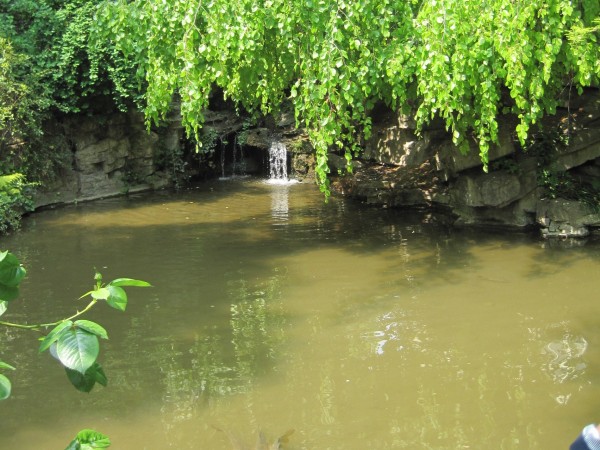
Omigosh, this little pond even had a waterfall.
This place was so perfect I idly wondered if that waterfall
was real. I studied it carefully. Yes. With an
odd sense of regret at just how delightful this spot was,
I concluded the waterfall was real.
|
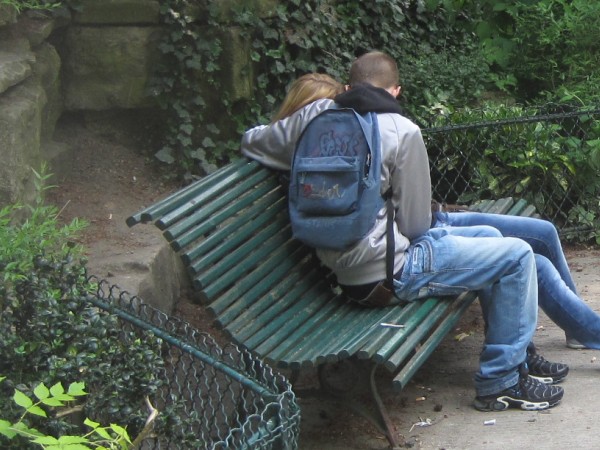
Now if ever there was a perfect spot for romance, this
park had
to be it. Sure enough, as if almost on cue, we ran
across a young couple in the midst of kissing.
|
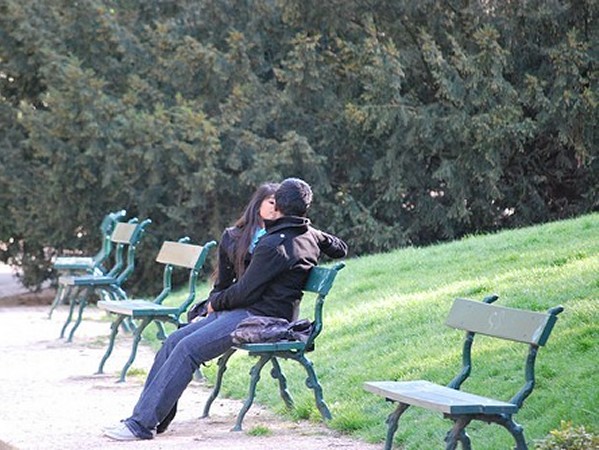
And then just around the corner I
found another couple as well. More smooching.
This park definitely had a romantic effect on people.
I remember wondering where I would go in Houston to find a
place with a similar effect.
|
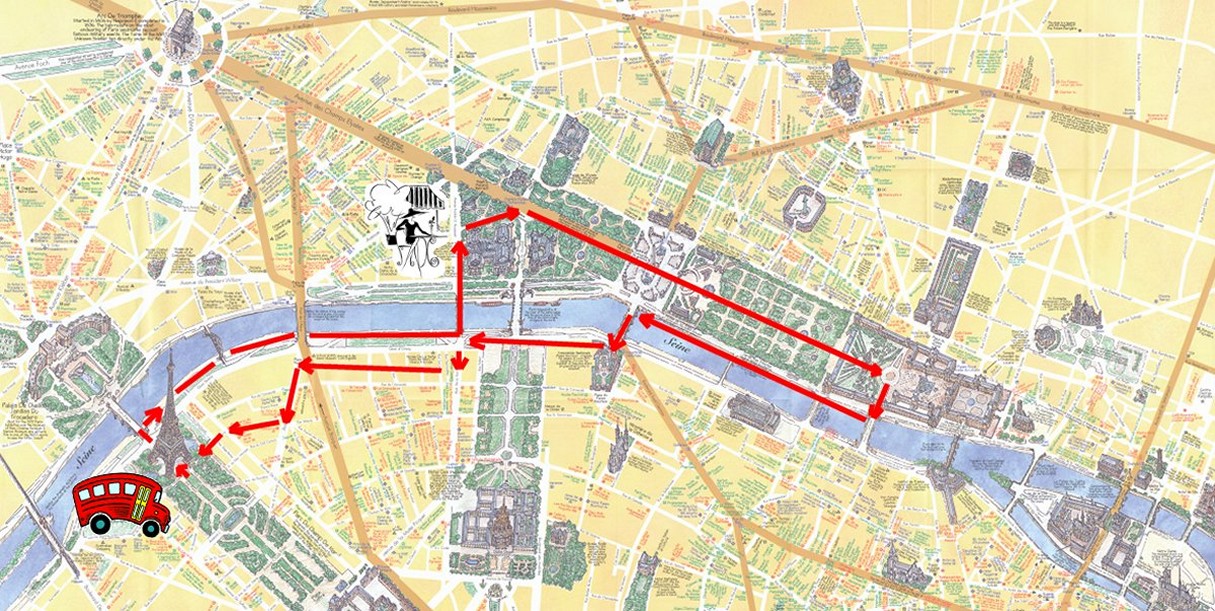
We decided to eat lunch
in the spot shown above. If you want to find the little park,
it was near our cafe across the street.
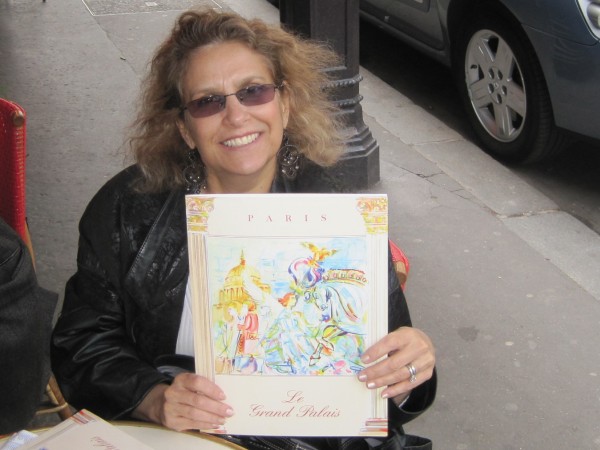
We decided to
have lunch since it was about 12:30 pm. We found a
lovely cafe named "Le Grand Palais" at the corner of Avenue FDR and
Rue Jean Goujon. This was the spot where Marla
discovered she didn't have much of an appetite. I ended up
eating most of her croissant.
|
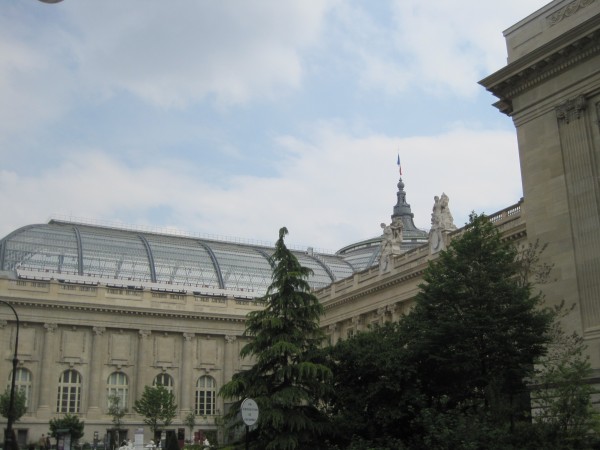
Given its name,
it is no surprise to find our restaurant
was located right across the street from the Grand Palais.
|
| |
|
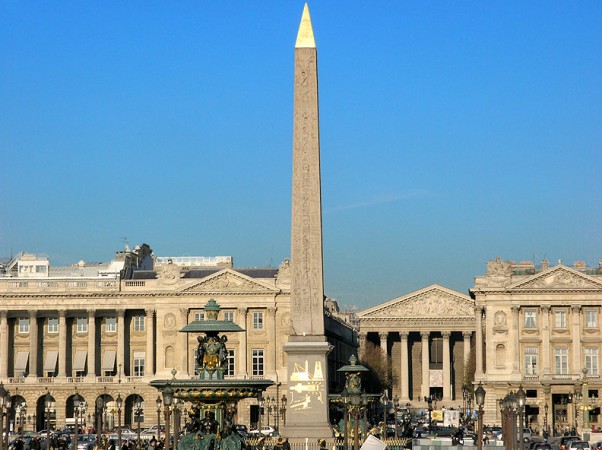
The Champs-Élysées dead ends at this
amazing obelisk.
This is the Obelisk of Luxor, a 75
foot high obelisk standing at the center of the Place de la
Concorde. Two 3,300-year-old twin obelisks once marked the entrance
to the Luxor Temple. Muhammad Ali Pasha, the self-proclaimed
Khedive of Egypt, offered the two
obelisks as a gift in 1829.
|
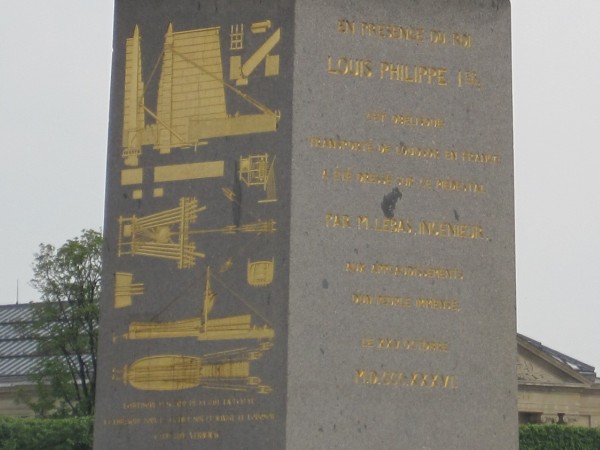
Notice the
hieroglyphics at the base. After this obelisk was
transferred from the Luxor
Temple to France, its partner was never actually brought
over and remains in Egypt.
The first obelisk arrived in Paris on December 21, 1833.
Three years later, on October 25, 1836, King Louis-Philippe
of France had it placed in the center of Place de la
Concorde.
|
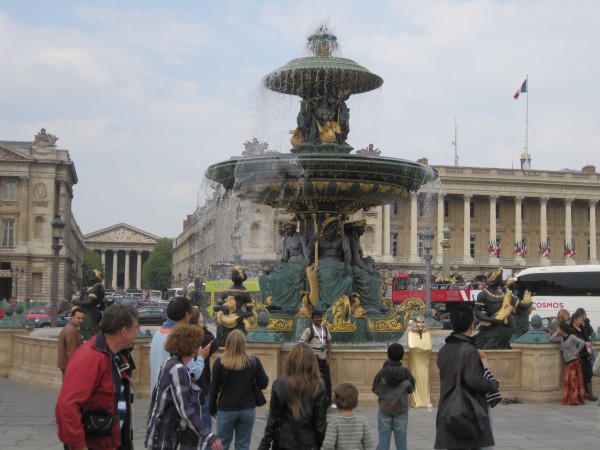
There are two beautiful fountains that
flank the Obelisk. This one is the Fountain of River
Commerce and Navigation. Directly behind to the right is the
Hôtel de Crillon which served as headquarters to the German
high command. To the left is the Embassy of the United
States. Interesting symbolism - captivator and
liberator side by side.
|
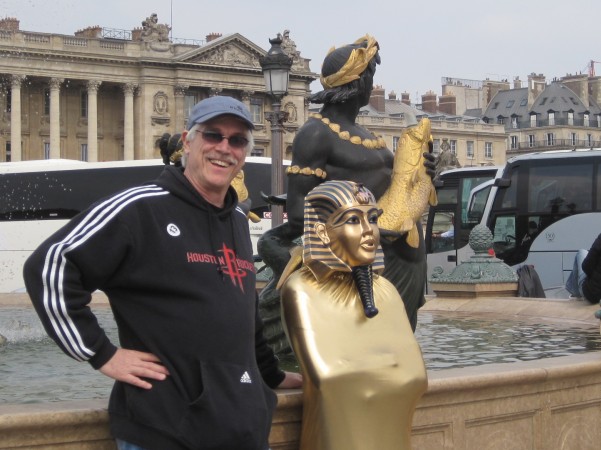
I made a friend with this cute girl
from Egypt. Well, sort of.
|
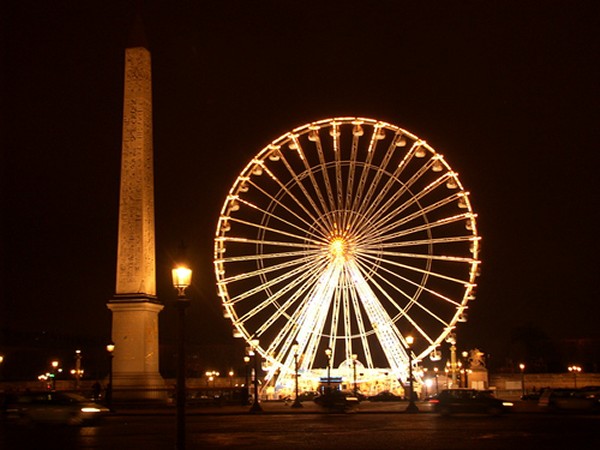
The Place de la Concorde is the largest public square in
Paris. The square was once known
as "Place Louis XV" and featured his statue. During the
French Revolution, the statue of
Louis XV was torn down and the
area renamed "Place de la Révolution".
The new revolutionary government erected the guillotine in
the square, and it was here that King Louis XVI was executed
on 21 January 1793. Other important figures guillotined on
the site, often in front of cheering and
jeering crowds, were Queen Marie Antoinette, Princess
Élisabeth of France, Charlotte Corday, Madame du Barry,
Georges Danton, Camille Desmoulins, Antoine Lavoisier,
Maximilien Robespierre, and Louis
de Saint-Just.
The guillotine was most active during the "Reign of Terror",
in the summer of 1794, when in a single month more than
1,300 people were executed. The Obelisk now stands in the
spot where Louis XVI was executed.
|
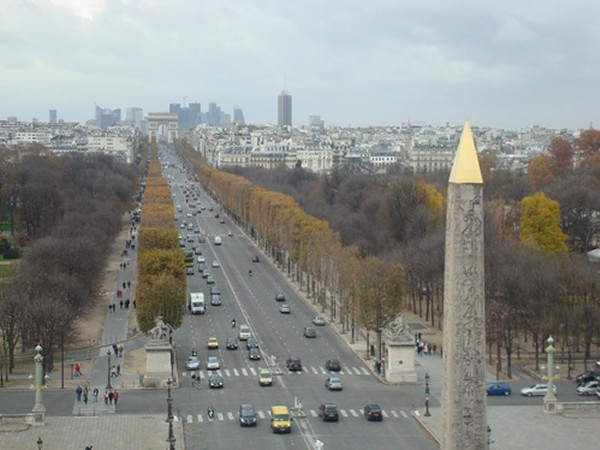
Here is an interesting picture of the
Champs-Élysées that shows the Arc de Triomphe facing the
Obelisk.
Speaking of the beheaded Louis XVI,
few people realize that America owes its Independence to
this man. Louis XVI was persuaded by Benjamin
Franklin to come to the aid of the American Revolution.
Upon securing a vital military alliance with France in 1778,
the war soon turned in the colonists favor. French
money, military expertise (e.g. Lafeyette), munitions, soldiers and naval forces proved essential
to America's victory over the Crown.
Ironically, France gained little in
return except for large debts. The treasury was now
completely bankrupt. The consequences of the resulting
fiscal crisis led directly to the French Revolution in 1789
and Louis XVI's death in 1793. While America gained
its Independence, Louis lost his head.
|
|
|
|
Our next stop was the magnificent Garden
of the Tuileries.
The Tuileries Garden is a public
garden located between the Louvre Museum and the Place de la
Concorde. Created by Catherine de Medici as the garden of
the Tuileries Palace in 1564, it was first opened to the
public in 1667.
It became a public park after the
French Revolution. Throughout the 19th and 20th century, it
was the place where Parisians celebrated, met, promenaded,
and relaxed.
Today the Tuileries Garden is one of the most
popular tourist destinations in all of Paris. The
beauty of the Garden is world famous. Over the
centuries, the Garden has become home to fountains, ponds,
exquisite landscaping as well as countless beautiful
statues. I will show the statues shortly. I
think people would be surprised to learn the origin
of the many impressive statues in the park.
On October 6, 1789, as the French
Revolution began, King Louis XVI was brought against his
will to the Tuileries Palace. The garden was closed to the
public except in the afternoon. Queen Marie Antoinette
and the Dauphin were brought here as well.
After the King's failed attempt to
escape France, the surveillance of the family was increased.
Then things got worse.
On August 10, 1792, a mob stormed the
Palace, and the King's Swiss guards were chased through the
gardens and massacred. After the King's removal from power
and subsequent execution, the Tuileries became the National
Garden of the new French Republic.
It was "the people's
garden" now. In 1794 the new government assigned
the renewal of the gardens to the painter Jacques-Louis
David and his brother in law, the architect August Cheval de
Saint-Hubert.
They conceived a garden decorated with
Roman porticos, monumental porches, columns, and other
classical decoration. They knew just where to find
some very beautiful statues. Large numbers of statues
were brought from the royal residences here to the Gardens for
display. These fabulous works of art remain here to
this day as an ironic "gift" to the people from the Royalty.
|
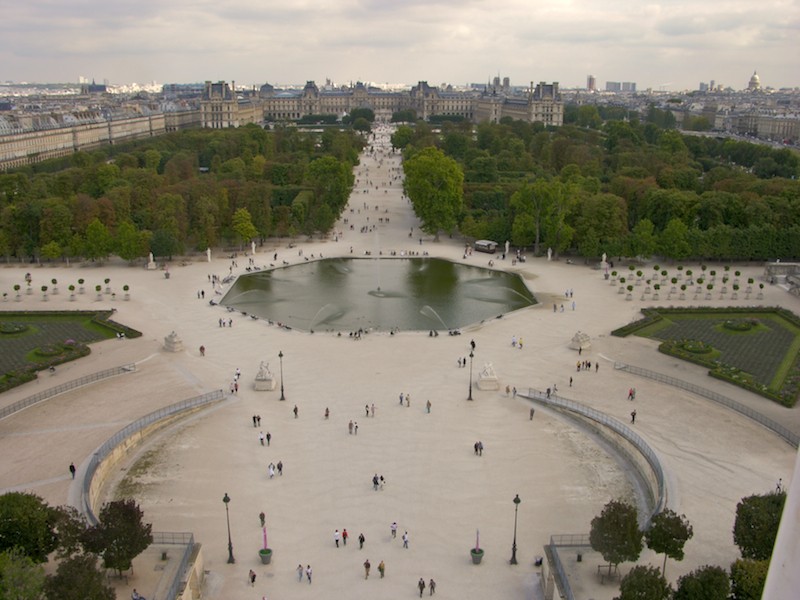
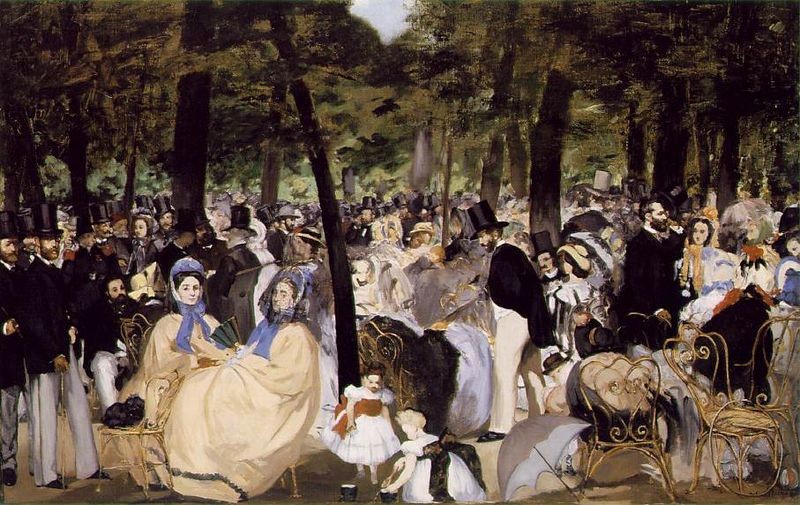
Music in the Tuileries, by Edouard
Manet, 1682...
the Tuileries was the favorite meeting place of Paris |
| |
|
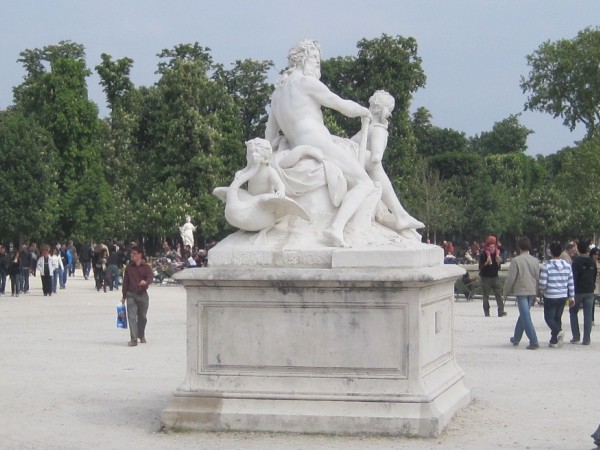 |
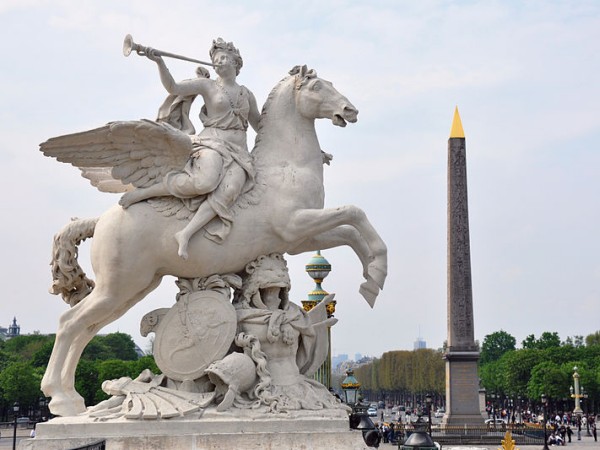 |
| |
|
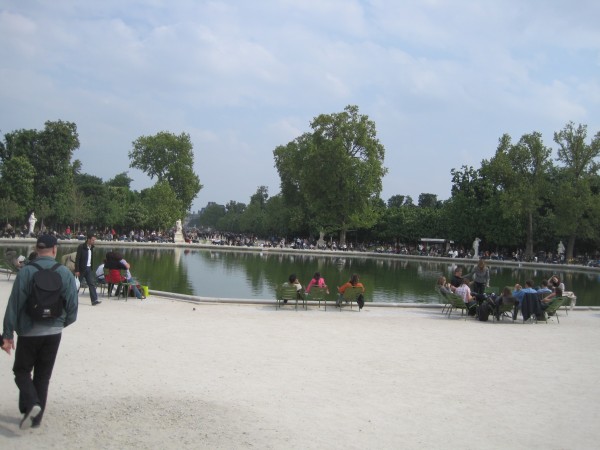
Practically the first thing we
encountered was this lovely pond known as the Grand Bassin
Octogonal. The pond is lined with a series of very
beautiful statues. Since I am a huge fan of statues, I
took great pleasure in taking their pictures.
|
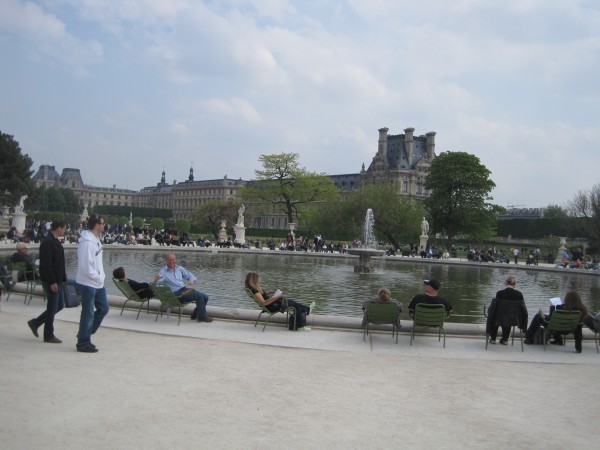
Since we were in
a hurry, I didn't have time to learn the names. Sad to say, I have no idea what the
names are or who created them. I did manage to
figure out the one directly below is Theseus and the
Minotaur.
|
| |
|
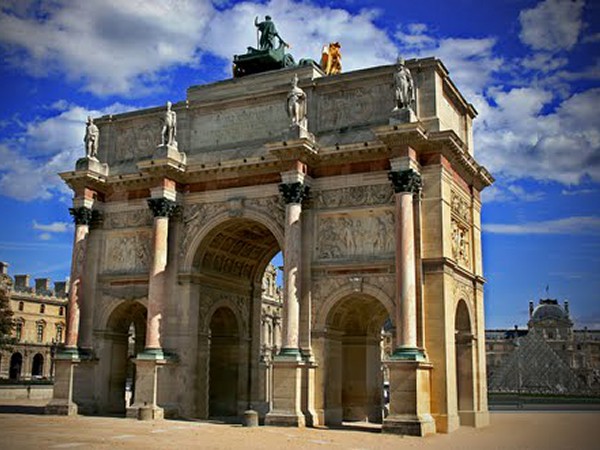
Our next stop was the "Arc de Triomphe
du Carrousel". It was built between 1806 and 1808 to
commemorate Napoleon's military victories of the previous
year. The more famous Arc de Triomphe de l'Étoile on the
Champs-Élysées nearby was designed in the same year,
but it took thirty years to build and is about twice the
size of this monument.
|
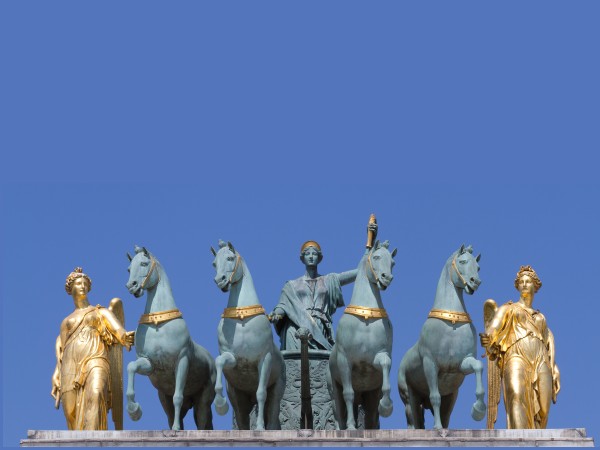
Peace riding in a triumphal chariot
(located atop the Arc).
By the way, these two pictures are
taken from Wikipedia. I could have used my own
pictures, but these were superior photos and I didn't think
the reader minded if I used the better snapshot.
|
This picture is titled Military
review in front of the Tuileries, by Hippolyte Bellangé,
1810The Arc de Triomphe du Carrousel, which can be
seen on the right of this painting, was originally erected
as a gateway of the Tuileries Palace
seen in the picture.
The Tuileries Palace was where Marie
Antoinette and King Louis XVI were held prior to their 1793
execution.
The Tuileries Palace no longer stands.
It was deliberately destroyed by fire in 1871. This took
place due to a political upheaval following France's defeat
in the 1870 Franco-Prussian War.
Today there is much talk in Paris of
rebuilding the Palace. The space where it once stood
is still vacant. Since the nearby Louvre is in
desperate need of room for expansion, there is a good
chance the project will take place.
|
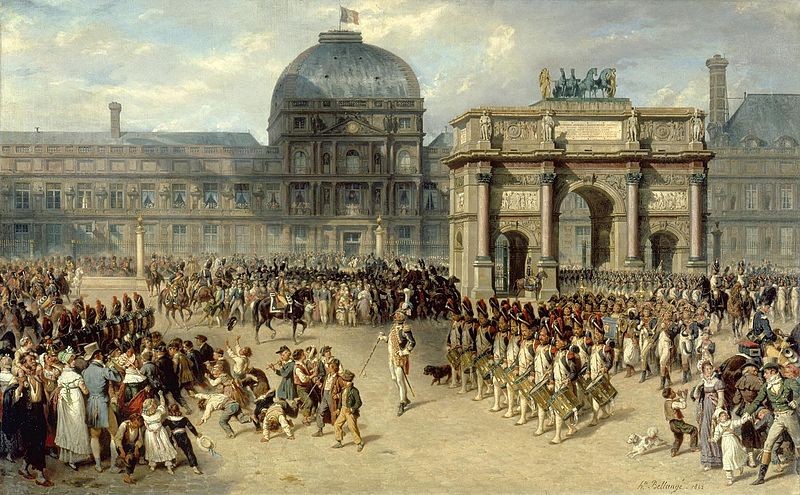 |
| |
|
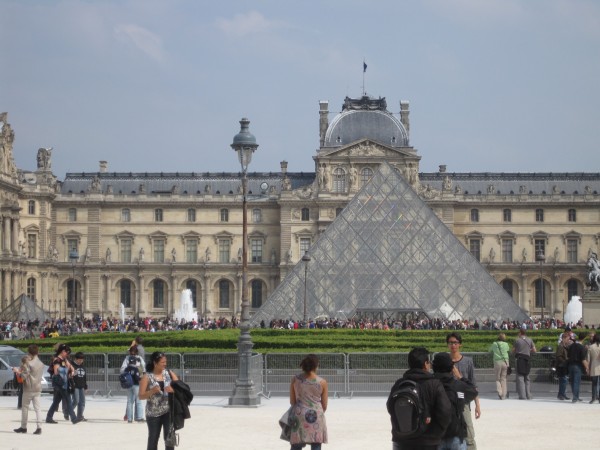
This is architect I.M. Pei's impressive
Glass Pyramid skylight which was completed in
1989. It serves as the entrance to the Louvre.
|
Now it was time for the Louvre.
This is the moment we had waited for. Some of the most
famous works of art in the entire world are housed at the
Louvre, including the Mona Lisa, Venus de Milo,
and Psyche and Cupid.
In anticipation of this moment, I had
created a wonderful 6-page article on the
Louvre
complete with 47 pictures and information about the best
known paintings and sculptures.
After finishing my article, I felt
like I was something of an authority. This was it. We were finally
here at the most famous museum in the world.
My heart throbbed with excitement. I had waited my entire life to see
this.
|
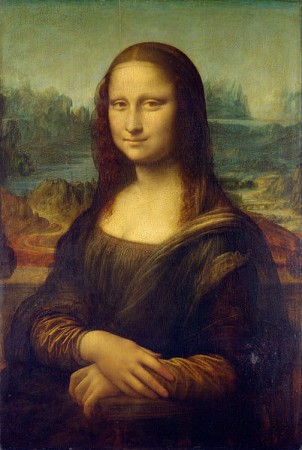
Mona Lisa,
Leonardo da Vinci's masterpiece.
|
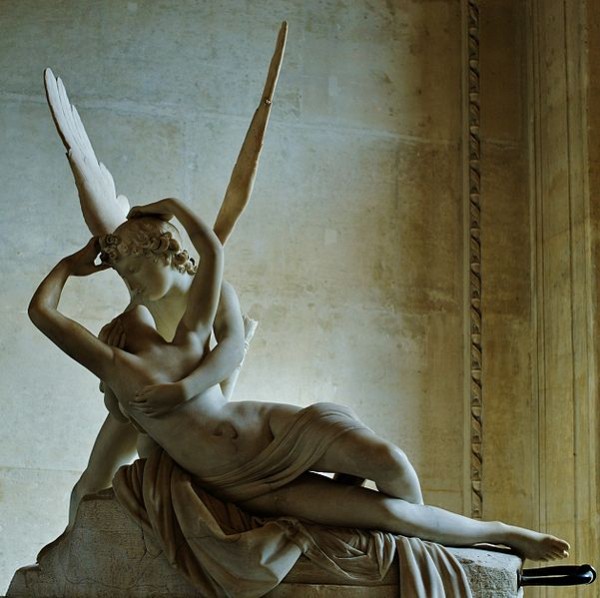
Psyche Revived by Cupid's Kiss,
by Antonio Canova |
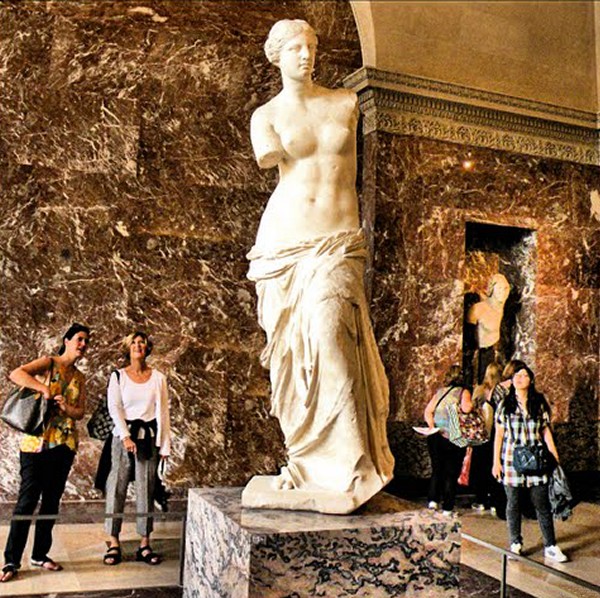
Venus de Milo,
by Alexander of Antioch |
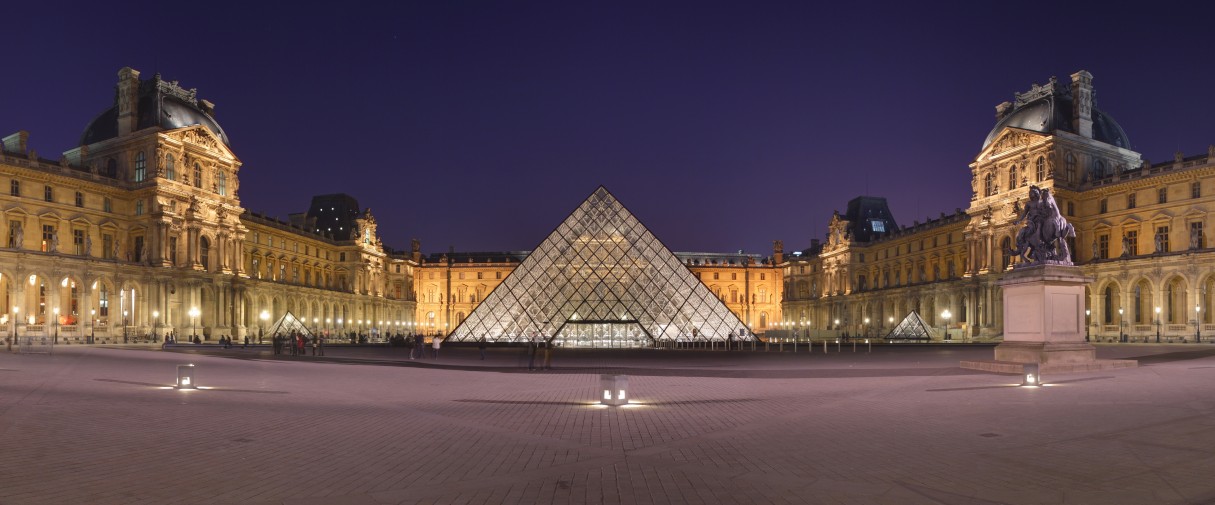
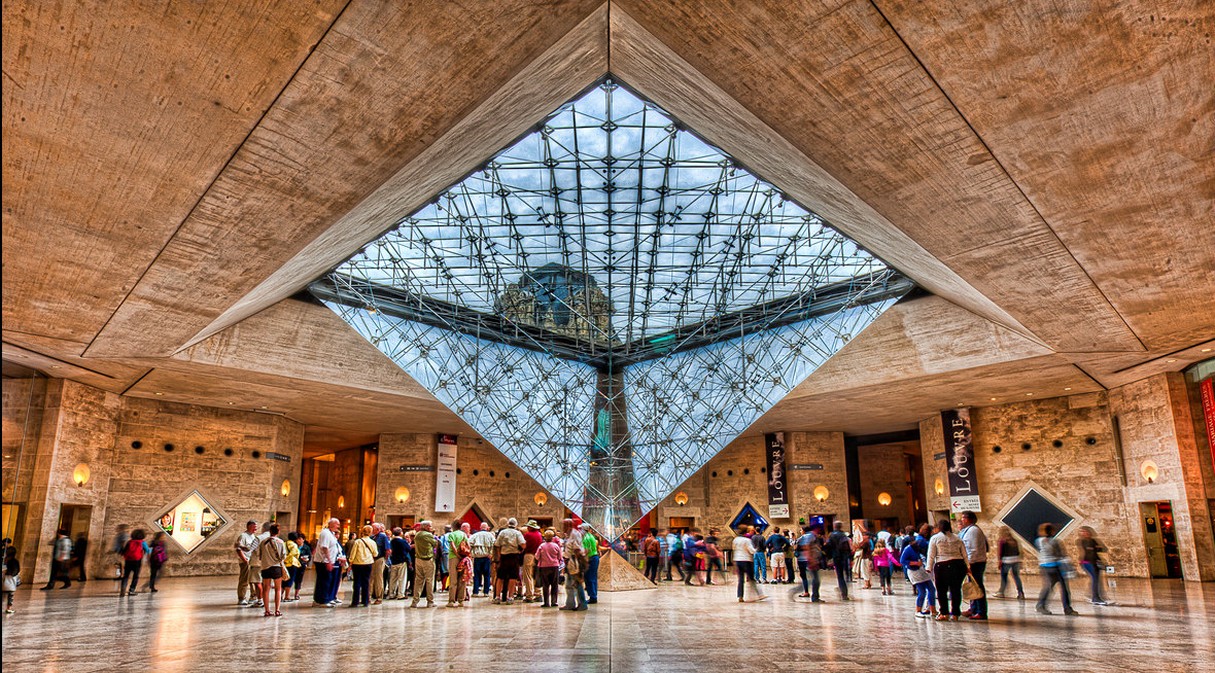
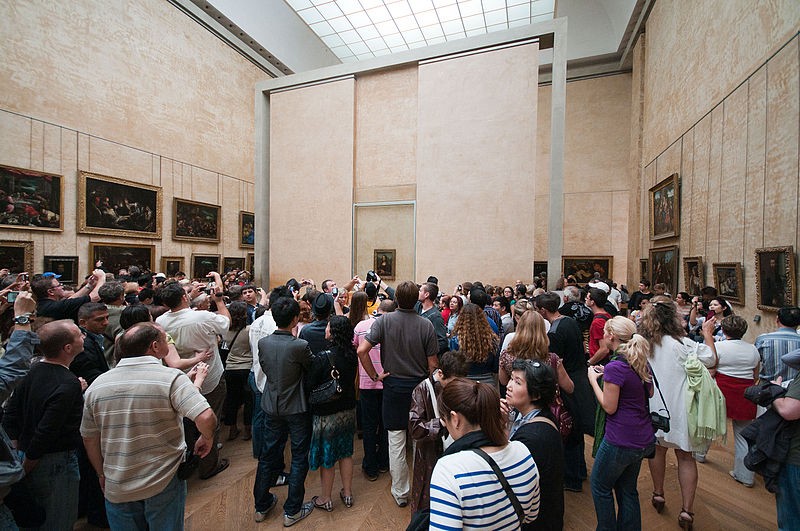 |
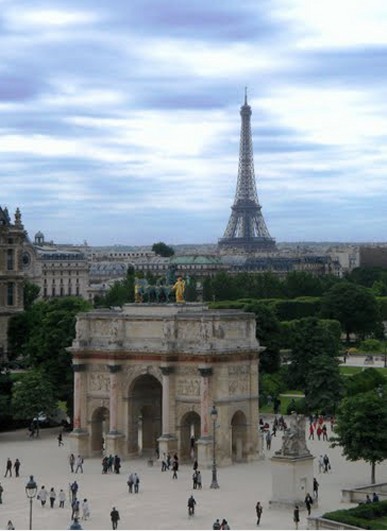 |
I did not take this picture of the crowd
staring in awe at the Mona Lisa. Why not?
When Marla and I
reached the entrance to the Louvre Museum, we had a small problem. The
Eiffel Tower was 2 1/2 miles away and we had an hour and a
half left. The Tower looked so far away, we weren't
even sure if we had enough time
to get back to our bus for the 4 pm rendezvous.
Marla and I were
both crushed. There would be no Louvre for us today. So close yet so far. Our
disappointment was overwhelming.
For lack
of anything
better to do, we went over to have a closer look at the
Glass Pyramid.
As I read the caption explaining the
Louvre in general and specifically the Pyramid, I noticed
this
blurb:
"Since
completion of the Pyramid in 1989, as of
2002,
attendance at the Louvre has doubled."
|
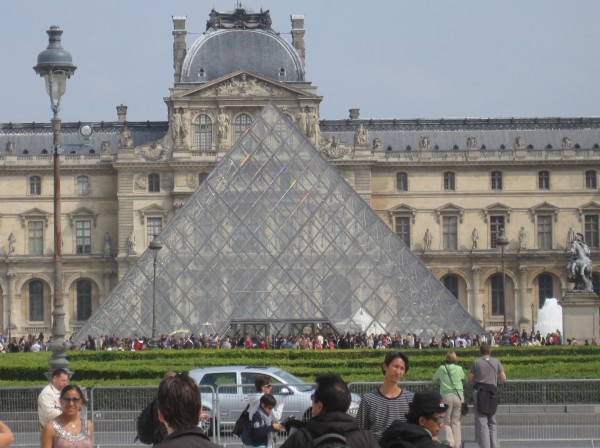 |
Houston Needs to Get its Act
Together
|
2002
Hmm. I remembered that
year for a very odd reason. That was the year I
volunteered to help with Houston's 2012 Olympic bid.
"Envy" is not the easiest emotion in
the world to deal with. As I stared at the Louvre, the
Pyramid and all the amazing statues, I again could not help
but compare my hometown to the amazing sights of Paris.
I thought back to how mystified I was in 2002 to discover
that Houston never had the slightest chance at winning the
bid for the 2012 Olympics that eventually went to London.
Paris finished second.
Truth be told, I
was about as "un-worldly" as possible back in 2002.
Other than a 1991 cruise to the Eastern Caribbean and a 1998
cruise to Jamaica and Cayman, I had never been anywhere else
in particular. It would not be until 2008 that I would
get my first look at Europe. My inexperience with
travel left me quite naive in my outlook concerning my hometown of
Houston.
I didn't know if
Houston would win the final Olympic bid or not, but I was
certain Houston was at least the finest American city to host the
Olympics in case the committee wanted to return the Summer
Games to the USA.
Look at things
from my perspective. Back in 2002, Houston had just
completed or was about to complete all the fine sports
facilities we have such as Reliant Stadium, Minute Maid Park and Toyota
Center. Plus we had the Astrodome to host other
events. Better yet, we had this new monorail system
that connected all the facilities into one nice line.
Any visitor to the Houston Olympics could use the monorail
to whisk them from one venue to another. I assumed at
the time that Houston was a LOCK to sew up America's bid to
host the 2012 Olympics... only to be crushed to find that
New York and San Francisco were selected ahead of Houston.
Not only was Houston unable to beat the great cities of the
world, it couldn't even beat the cities in its own country.
I didn't get it at the time.
Houston had by far the finest facilities necessary.
But based on the results, it didn't seem like anyone was
interested in my city. Houston didn't seem to have a
chance.
It was not until I began to visit
cities like Paris, Rome and Barcelona that I finally figured
out what Houston was missing - Beauty. If Paris is a Beauty, then Houston is a concrete
Beast.
By chance I
saved
this thoroughly obnoxious article in the San Francisco Chronicle that summed
up the reasons for Houston's also-ran status.
Hey Houston... Better luck next
time!
Ken Garcia, San Francisco Chronicle
Published 4:00 am, Tuesday, September 3, 2002
Houston's
Olympics bid had it all -- except a sellable city
There's no denying that San Francisco's politics are a
joke. The city's streets are a mess, its real estate
prices are laughable, the city is congested, and it's hardly
commuter-friendly.
But even with all its bureaucratic bungling and aging
blemishes, San Francisco is still one of the most
beautiful cities in the world. And more important,
it's not Houston.
This undeniable fact was not lost on the U.S. Olympic
Committee task force that selected San Francisco and New
York as the finalists to be the U.S. candidate for
hosting the 2012 Summer Olympics. And it underscores
what so many cities over time have learned in trying to
chip at the stature of San Francisco and belittle its
standing as a world-class tourist destination: better
luck next time.
For years, cities from Toronto to Tampa Bay have tried
to convince big city officials and big league teams that
San Francisco was somehow becoming second-rate. As
they would say, Frisco is still pretty
as a postcard, but definitely on the
decline.
While longtime residents here might agree with
that assessment, when neutral observers asked visitors which city they'd
rather spend time in, somehow Houston, Dallas, St. Petersburg
and Pittsburgh don't make the list. It's not even
close.
A certain civic sneer emerges on the countenance of
other city officials when San Francisco is mentioned in
any capacity, an uncontrollable impulse based on the
town's reputation for wackiness, openness and
outrageousness. But often lost on them is the City by
the Bay's
elegance, sophistication and hard-earned ability to
cater to the most cosmopolitan tastes and attitudes.
Our city has qualities that towns like Oakland, San Jose and
Sacramento have learned to accept about San Francisco
over time. Our competitors note San Francisco's
superior attractiveness. They do so with reluctance and with envy-induced
hostility at times, but still without question.
So it's rather amusing that second-tier towns like
Houston continue to huff and puff when they get left at
the threshold when competing against the San Franciscos
of the world -- or for that matter, the likes of London and
Paris and New York.
Houston is
definitely big, admittedly
super-sized in a Texas-Astrodome-LBJ kind of way. And
according to those involved in the Olympic hosting
competition, Houston had the most technically and financially
sound bid among the municipal hopefuls.
Houston only had one problem. It's Houston.
"They can crunch the numbers, spin the truth and do more
recounting of the votes than the state of Florida, and
it always comes back to one point," wrote
Houston Chronicle columnist Fran Blinebury, echoing the
sentiment of the town's official delegation. "Image is
everything. In the end, the 10 deciding members of the USOC task force voted with their hearts and their
digital cameras instead of their heads."
Blinebury's commentary came on the heels of another
Houston sports scribe, John P. Lopez. Lopez claimed that
without all of its
pizzazz and sexiness and popularity and allure, San Francisco wouldn't even stand a chance.
And he's right. For without all of those traits, San
Francisco would be Houston. With better weather.
This last point should not be ignored because in the
minds of Houston officials, their town's hell-like
summertime heat was a major reason for elimination. They
tried to dodge that perceived problem by offering up a
plan showcasing an "air-conditioned Games" theme. Which
is to say, "We hope you like your marathons indoors."
Yet reality suggests that weather played but a small
role in the U.S. Olympic Committee's determination.
After all, Atlanta was a sticky, furnace-like host to
the 1996 Olympics. Nor did the heat stop officials from
selecting Athens for the upcoming 2004 Games.
We can only
assume the heat is a lame excuse for Houston. Maybe the committee really did want
an internationally renowned city and a perennial top
draw for tourists worldwide. If so, tough luck,
Houston.
Perhaps Houston was so desperate to put itself on the
global events map that chose to overlook the boring
flat-terrain flood basin where it is located.
Instead the
USA Olympic committee saw San Francisco, with its
lovely hills and bridges and cable cars, as the perfect accent
to a colorful, dynamic region that happens to include
beautiful sports arenas from San Francisco to San Jose
to Sacramento.
"I guess my idea of an international city and the USOC's
just isn't the same," said Houston 2012 Foundation
Chairman George DeMontrond III after the setback.
Houston is the home of NASA, so we'll forgive DeMontrond
for getting lost in space.
For all those civic wannabes in Houston who like to
think their city's stock is now on par with the likes of New
York and San Francisco, it helps to remember the small
things. The 110-degrees-in-the-shade concept is a sure
brochure bouncer. And oil refineries may be a great
boost to the local economy, but smoke and haze and
skylines full of petrochemical plants
don't exactly send Europeans racing to their travel
agents.
The good people of Houston will accept this over time,
just like all the other cities have when they try to
pass themselves off as San Francisco or Paris. Speaking
of Paris, that would be the one in
Europe, not the one in Texas.
Despite the snide
remarks, this article definitely made its point.
I think this article sums up my feelings about my 2010 visit to
Paris fairly well. Houston remains a terrific place to make
a living and raise a family, but who on earth would ever
think of Houston as a tourist destination? What are
people supposed to do when they come here?? What are
visitors supposed to do for entertainment?
San Antonio has the
Alamo and the River Walk and Austin has hills, lakes, and rivers.
Meanwhile all Houston does is endlessly widen its freeways, cut down
more trees, put up more billboards, and destroy Astroworld and Waterworld.
Our ideas of culture include monster truck exhibitions, gun
shows, and art cars. Paris has the Mona Lisa, Houston
has the beer can house.
Oh well. Now you know why I was
so depressed during my walk through Paris. This visit
to Paris had been a real eye-opener for me. Sometimes
"Ignorance" really is bliss.
For the rest of our
walk, I was engaged in a constant mental debate over whether
it is better to know or not to know that your hometown is
homely.
|
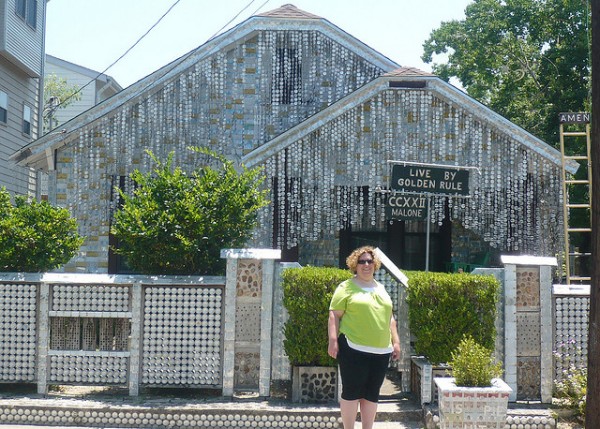 |
Or is the
adjective "homely" putting it too mildly??
Upon my return
to Houston, on a whim I typed in "Most Romantic Cities in
the World". Naturally Paris popped up immediately.
Out of nowhere,
I had a gruesome thought. How exactly does the rest of the
world view Houston??
With fear and
trepidation, I typed in "Ugliest Cities in the World".
Sure enough,
Houston made the list.
1 |
GUATEMALA CITY, GUATEMALA
2 | MEXICO CITY, MEXICO
3 | AMMAN, JORDAN
4 | CARACAS, VENEZUELA
5 | LUANDA, ANGOLA
6 | CHISINAU, MOLDOVA
7 | HOUSTON, USA
Houston,
we have a problem: You're ugly. This is the United
States' fourth largest city when it comes to
population, but the attraction sure isn't scenery.
There are many other ugly American cities (let's
face it -- American metropolises aren't exactly
beauties: Atlanta, Cleveland...), but this one
should win the title of ugliest of them all hands
down thanks to a large impoverished and homeless
population (close to one in five families live below
the poverty line) and an irregular cityscape with no
formal zoning regulations.
8 | DETROIT,
USA
9 | SAO PAULO, BRAZIL
10 | LOS ANGELES, USA
Okay, enough
Houston bashing for now. Paris has been the Grand
Master on the world stage for a thousand years.
Compared to Paris, Houston is barely a new kid on the block.
Our city is not even two hundred years old and look at all
the progress we have made!
The way I see
it, it is too bad that our city may lack hills and lakes and
mountains and mighty rivers. However, on the other
hand, Houston has many blessings. Houston has the good
fortune of being at the crossroads of national and
international trade routes. With our ship channel, the
cargo ships of the Panama Canal come beating to our
doorstep. Not only do Texas farmers and businesses use
Houston for its shipping, the entire southwest comes through
Houston to cruise the Caribbean and the Gulf of Mexico.
Planes to and from South America use Houston as the natural
launch point to the next stage. We are in the middle
of everything.
People make fun
of our climate, but we never have the crippling snowstorms
of the North. People make fun of our floods, but when
you stop and think about it, it is a blessing to have all
the waters of Texas come flowing past Houston. Ask Los
Angeles or Las Vegas if they would like to have some of our
water.
Houston is a
business town, plain and simple. Call it as it is.
Energy, Space, Medicine, Manufacturing, Shipping.
Houston is an economic powerhouse the envy of many cities
throughout not just the country, but the world for our
prosperity.
Houston is still
a kid. So during our growing phase, we are the ugly
duckling. We are still wearing braces. We have
made a conscious decision to knock down our trees to make
room for the
most elaborate freeway system on earth and suburban
development. By refusing to zone the city, we have made a conscious decision to
encourage business growth over neighborhood beauty. By
allowing billboards to be placed alongside freeways that
could be lined with trees, we again encourage business over
beauty. So
be it. Someday Houston will have its own
"Renaissance". I have no doubt that one day Houston
will turn its attention to greater urban beauty and cultural
development. However, for the moment its focus is
clearly on
economic growth.
Paris on the
other hand has the good fortune to be the epicenter of
European culture for the past thousand years. The
French have been world leaders in style, science, literature
and art all the way back to the days of Medieval Europe.
Paris is the envy of the world. For example, 300
hundred years ago Peter the Great of Russia took one look at
Paris and decided to model his own country after the French.
Peter absolutely could not bear to think how ugly his own
country was after seeing this pearl.
The nice thing
is that like Peter the Great, we are able to appreciate
Paris for its beauty and perhaps even aspire to make our own
city more attractive. Paris gives us an idea of what
we could do if we put our mind to it. For one thing,
our city could have just as many tree-lined vistas if we
could just let go of our obsession with billboards.
That said, from
my perspective,
Houston isn't going to be lovely any time
soon. So for the time being, I figure the easiest way
to cope with my envy is to at least share the beauty on
occasion. I am
just happy I can earn a good living here in Houston
so Marla and I can afford to visit a place like Paris.
|
Back to
the Garden of the Tuileries
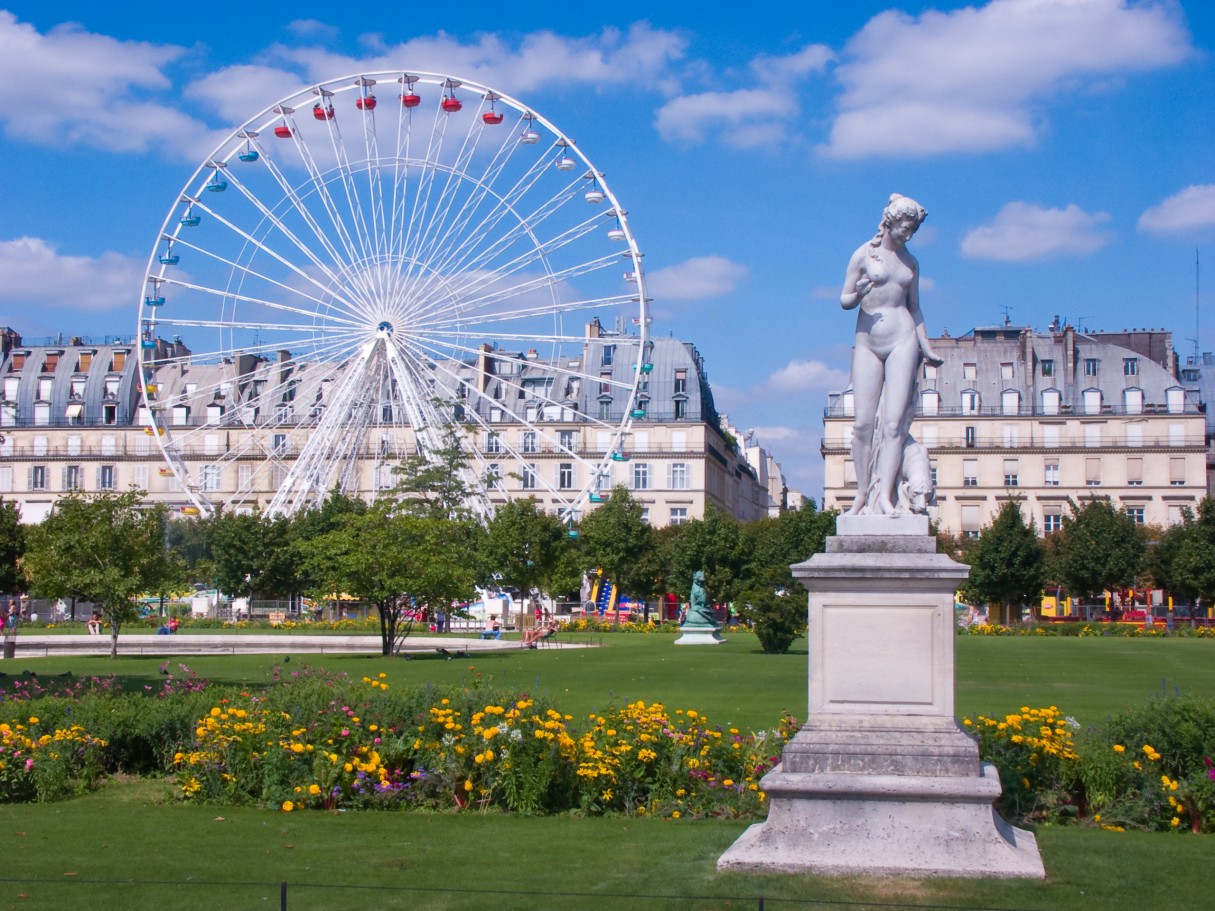 |
|
|
|
|
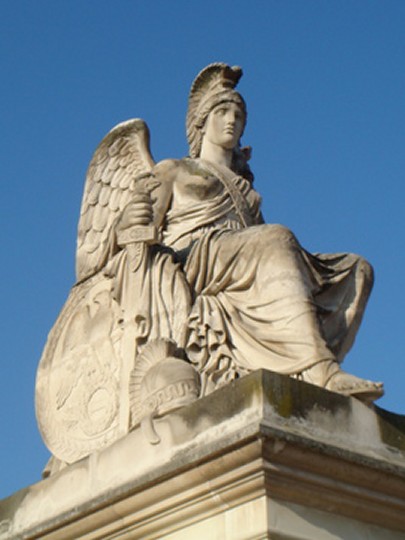
This statue was beside the Arc du Carrousel |
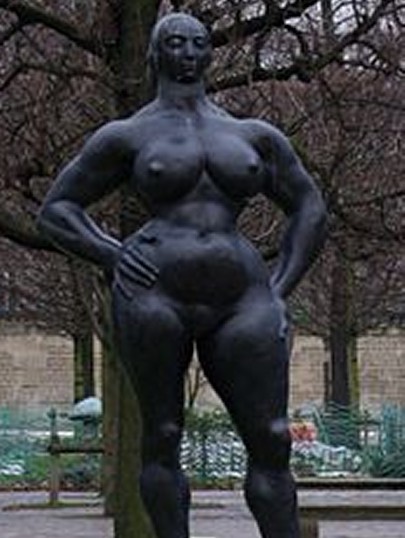
Standing Woman, Gaston Lachaise, 1932 |
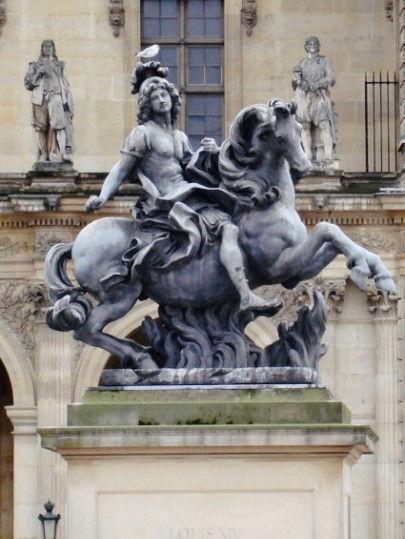
Louis XIV,
the famed Sun King, 1638-1715. Voltaire dubbed his reign "an
eternally memorable age," calling it
"le Grand Siècle" (the Great Century)
|
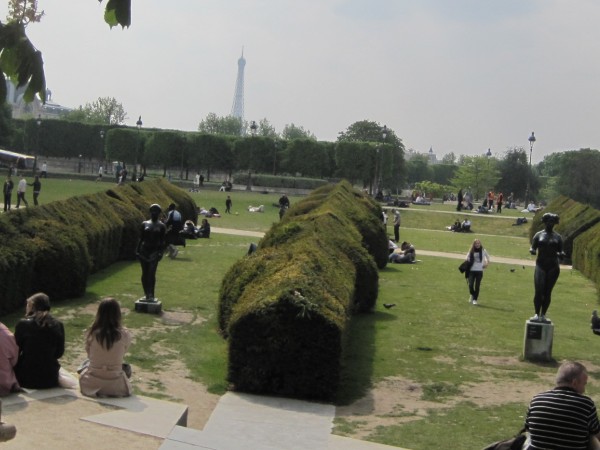
So much to see, so little time.
I desperately wanted to stick around and explore every
corner of this amazing garden. The problem was that
the Eiffel Tower looked really far away.
|
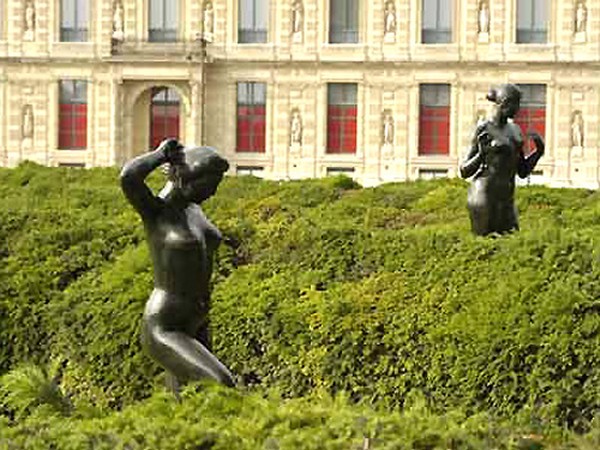
Marla and I were both worried that we
didn't have enough time to get back. So with great
reluctance, I stopped snapping photos of the Tuilerie
Garden statues and began to head back.
|
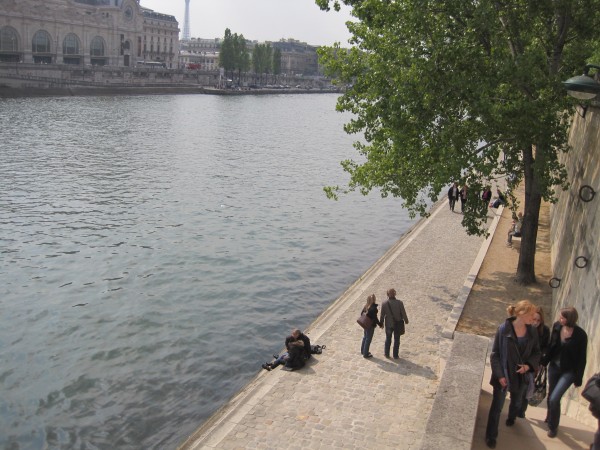
Marla and I decided to descend those
stairs and walk along the side of the Seine River.
|
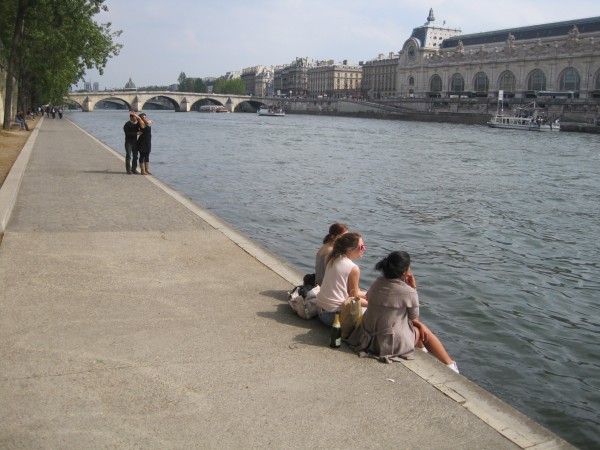
It is very lovely down by the river.
|
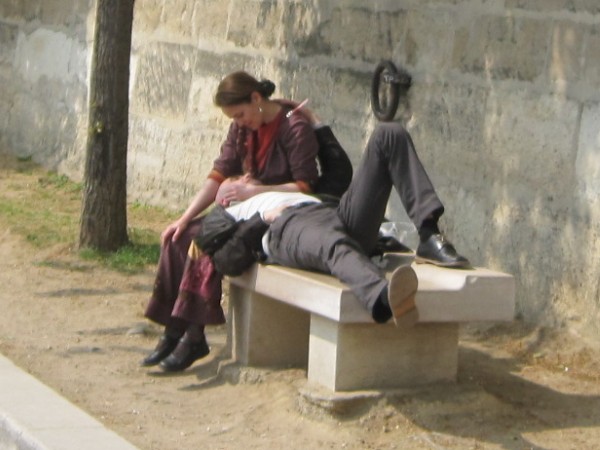
This area down at river level was a
veritable lover's lane.
|
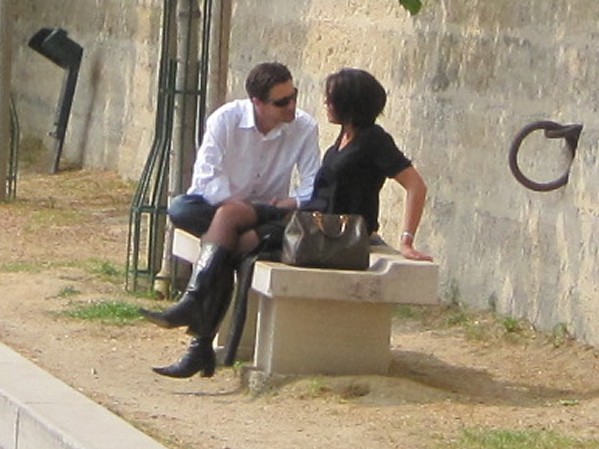
There were all kinds of couples in
the various stages of love.
|
| |
|

A look at the
Seine from the other side of the bridge. I shrugged my
shoulders in surrender. Who could deny the beauty?
|
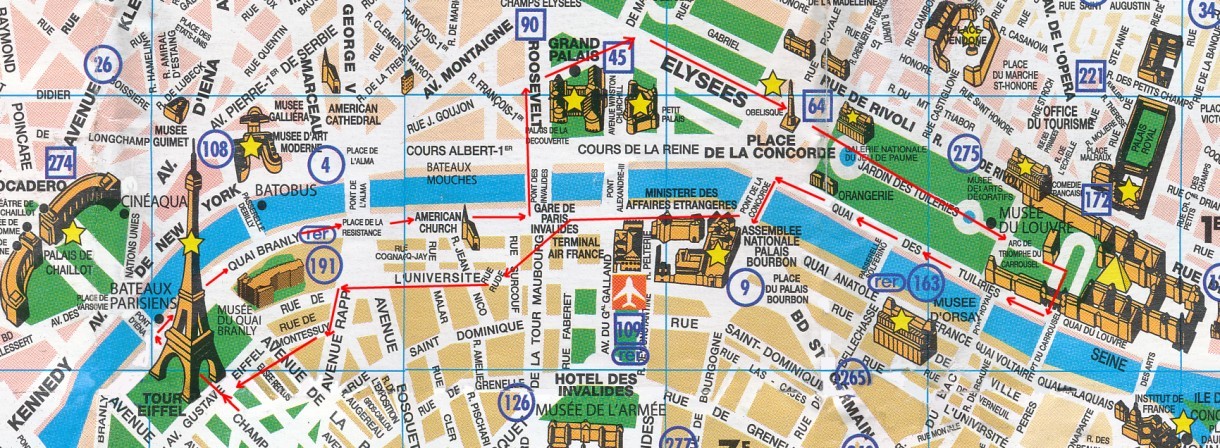
It was time to
head back to the Eiffel Tower. We walked along Quai
Branly for a while, named for Edouard Branly, the French
inventor. Then we switched over to Rue de Universite.
To our chagrin, we arrived back at the Eiffel Tower a half
hour early. It aggravated both of us to waste a single
second that could have been spent exploring.
|
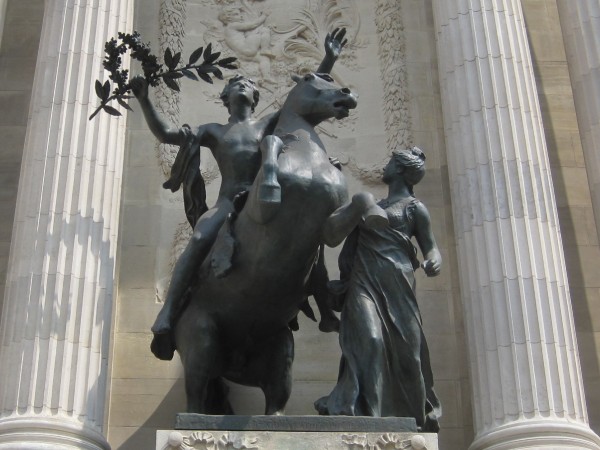
We passed one
museum after another. Each museum called for us to come
visit and learn, but it was too late for that. We both
frowned and accepted our fate.
|
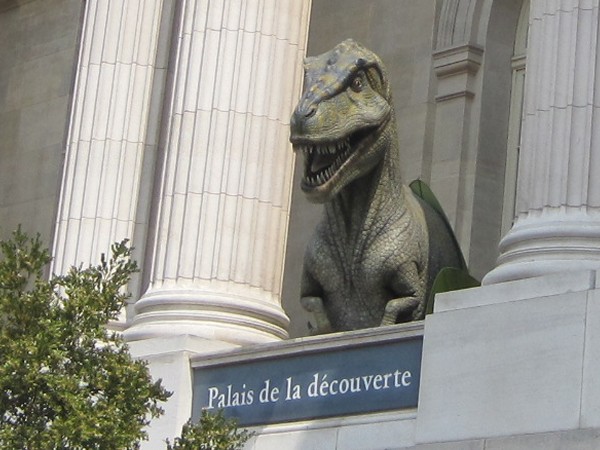
I was engaged in
yet another mental debate. Is it better to stay
ignorant of beauty that you cannot have or is it better to
know the beauty and have it quickly ripped from your heart??
|
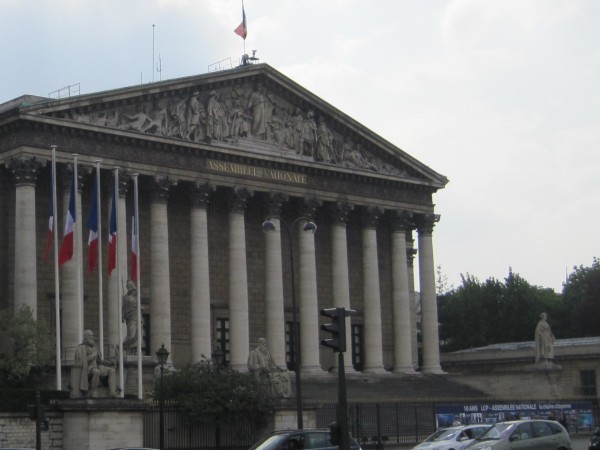
The National
Assembly meets here in what was once the Palais Bourbon
created by Louis XIV
|
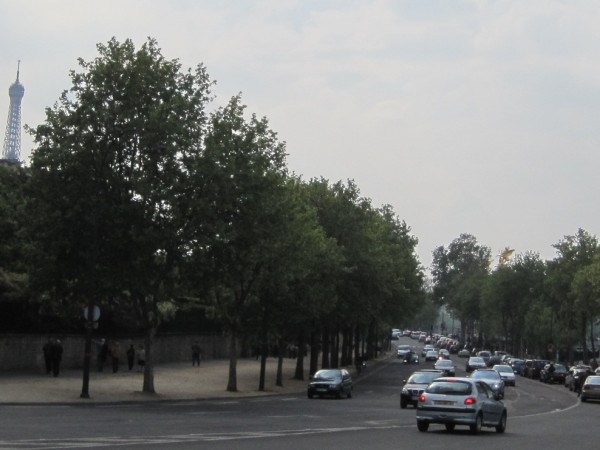
As I said
earlier, there was never a fear of getting lost thanks to
the Iron Monster. What fooled us was our inability to
realize the Tower was so much closer than we thought.
|
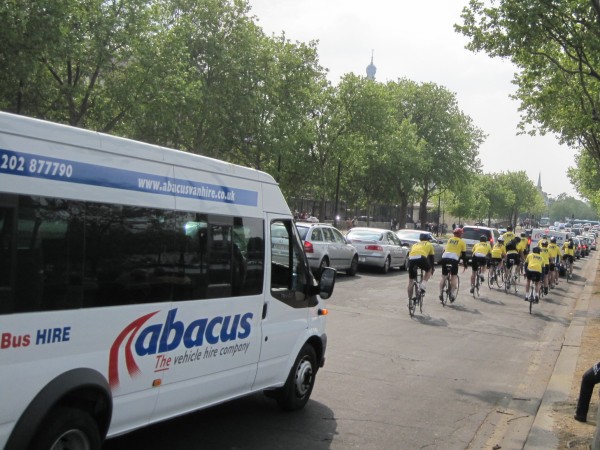
France, of
course, is home to the famed Tour de France. It wasn't
until I enlarged this picture that I realized this was an
official cycle team in training.
|
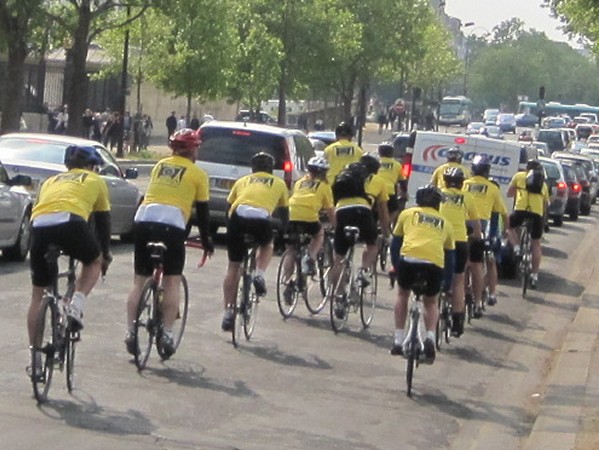
Obviously
someone hired the Abacus bus company to put a
vehicle in front and in back of the riders for their safety.
|
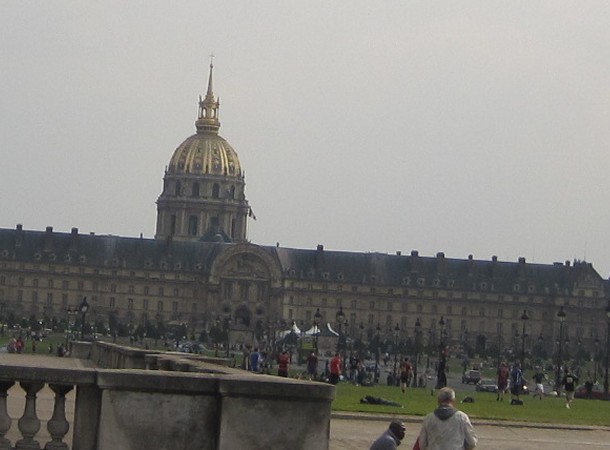
Hotel of the Invalides is a
complex of buildings that contain museums and monuments, all
relating to the military history of France, as well as a
hospital and a retirement home for war veterans, the
building's original purpose. The buildings house the Musée
de l'Armée, the military museum of the Army of France, the
Musée des Plans-Reliefs, and the Musée d'Histoire
Contemporaine, as well as the burial site for some of
France's war heroes, notably Napoleon Bonaparte.
|
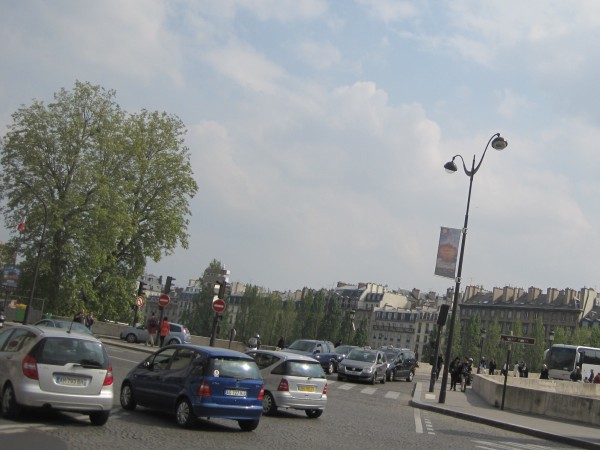
Here is some of
the most expensive real estate in the world. The
apartments that line the Seine are said to be in the "if you
have to ask, don't bother" category for price.
|
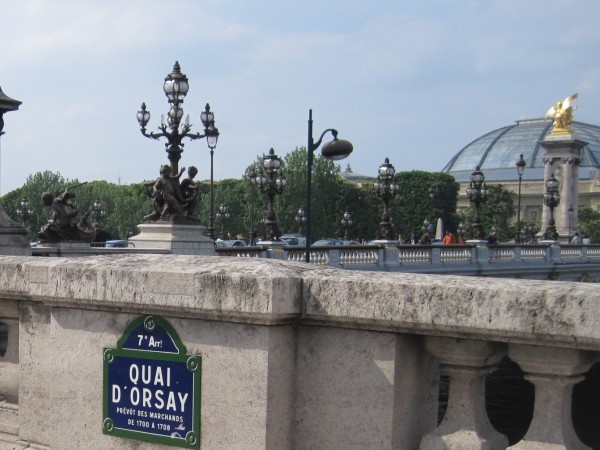
Now we are back
at the Pont Alexander III. I know this because I
recognize the golden statue. The main feature of Pont
Alexandre III is the four 56 feet tall pillars with the
shining gilded statues. These statues are known as the
Fames. Each one of these statues has a specific name
and each one stands for a specific period of Frances
history.
|
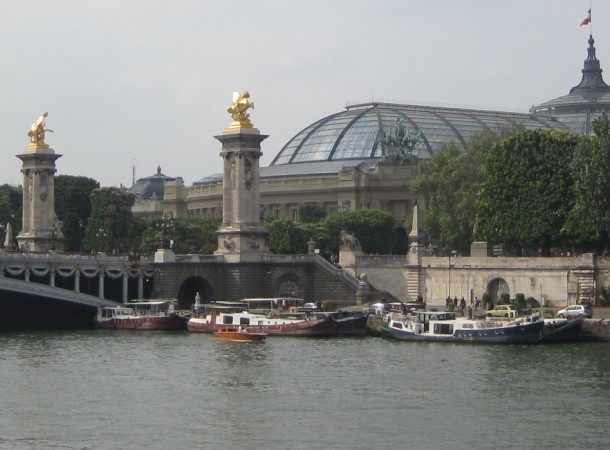
Another look at
the Fames and the Grand Palais. I can't help adding
all these statues! I love statues!!
|
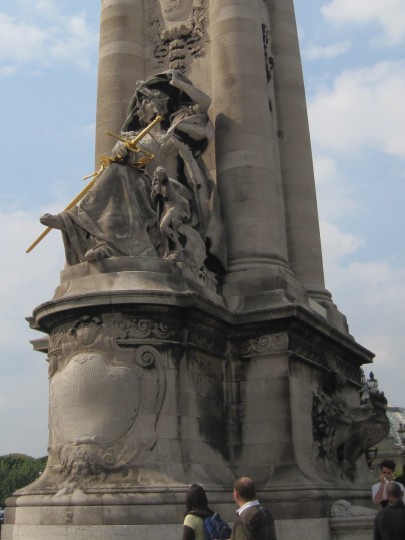
The base of the statue |
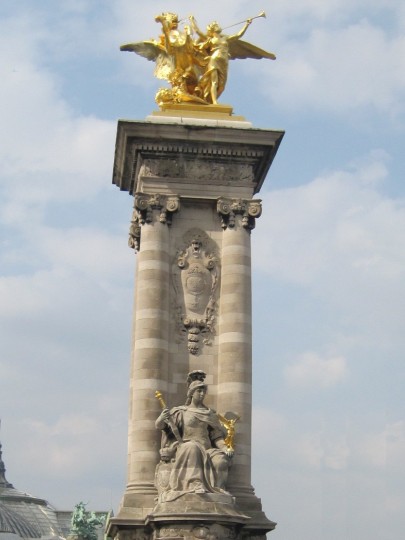
The top of the statue |
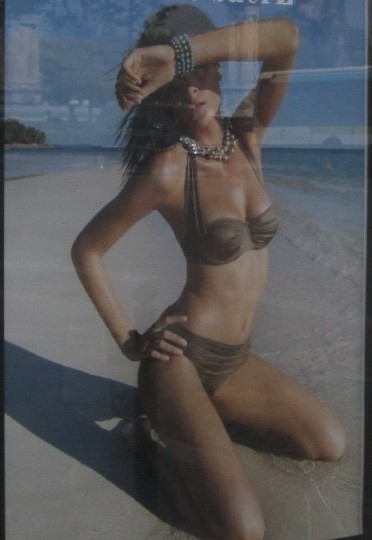
Statuesque |
| |
|
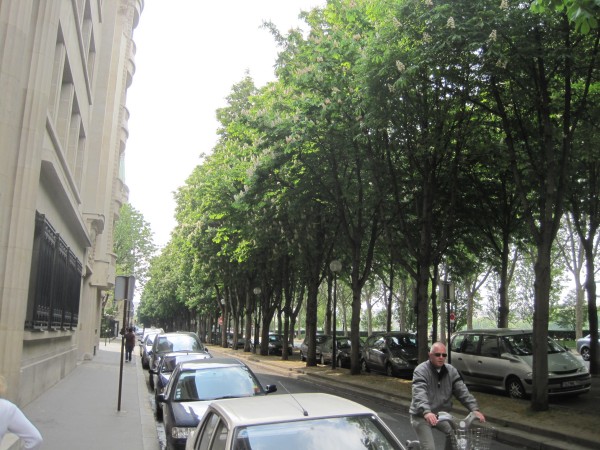
Heading towards
University Boulevard
|
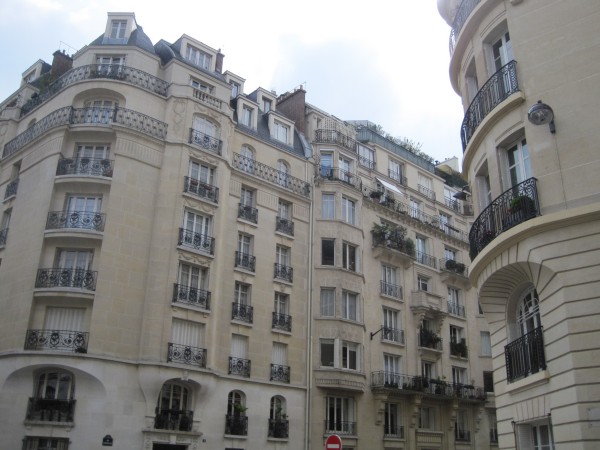
Unless I am
counting wrong, those apartments are 9 stories tall.
|
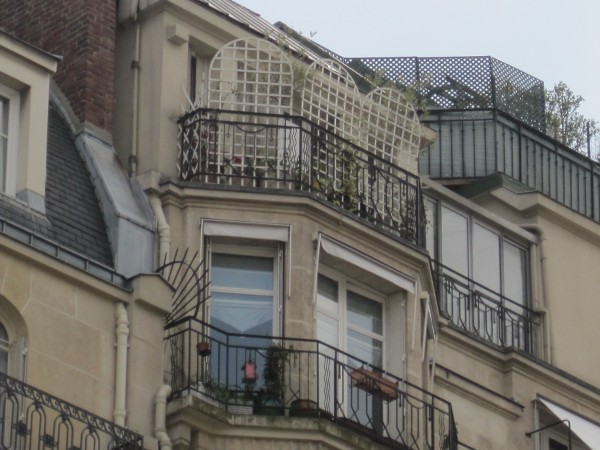
Many buildings
are crowned with delightful aerie gardens.
|
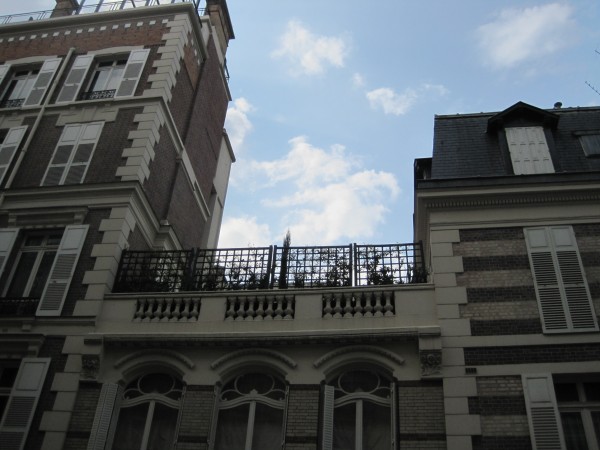
Another garden
in the sky.
|
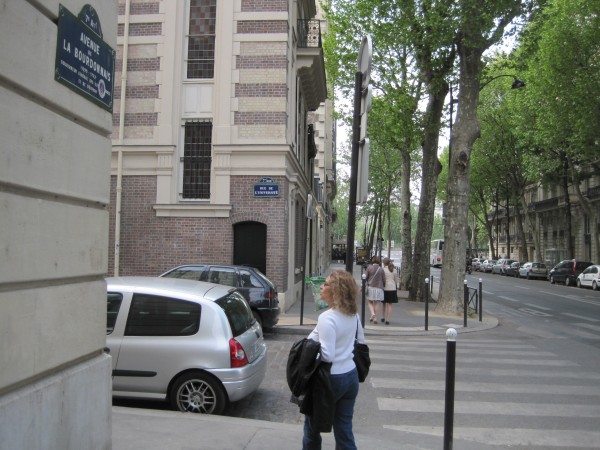
Trailing behind,
I noticed Marla suddenly stop in her tracks when she turned the corner.
And what did
Marla discover when she turned the corner??
Notice the tilt of her head. Her expression said it
all. Wow!!
Two blocks away,
there it was, the incredible Eiffel Tower.
Très magnifique!!
We walked on
ahead and soon came to an enormous city park that lay at the
footsteps of the Eiffel Tower.
With 30 minutes
to kill, I decided to explore the park. Marla was
exhausted, so she sat down on a bench and said go ahead without her.
I am not quite
sure what it was about that park, but there were people embracing and kissing everywhere I went.
|
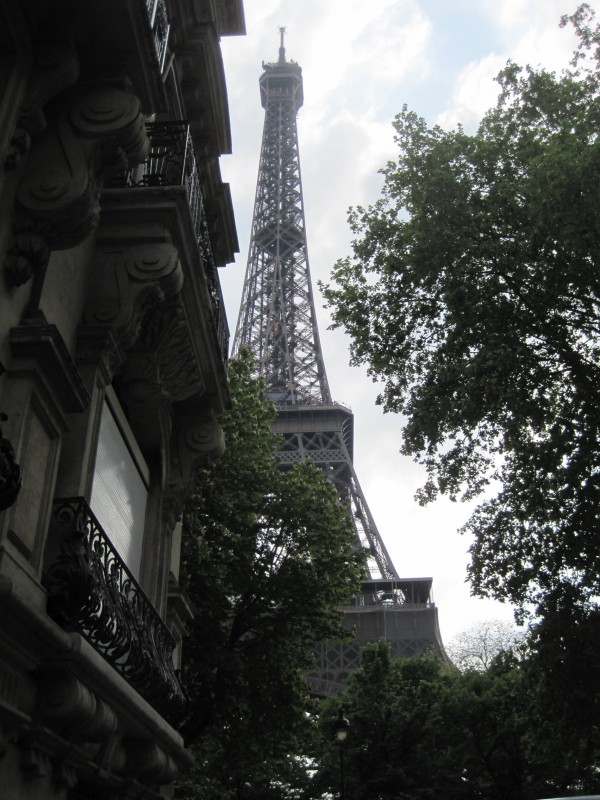 |
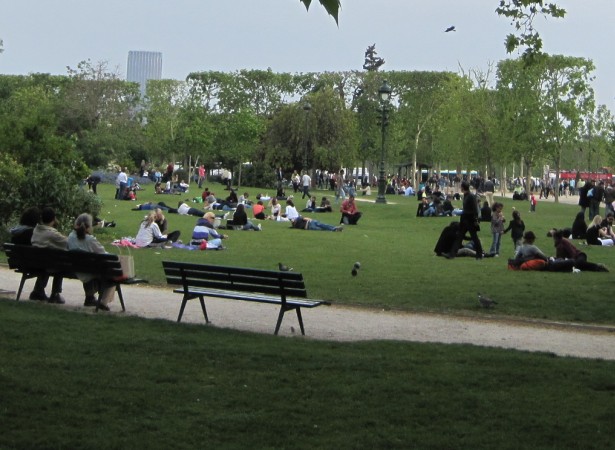 |
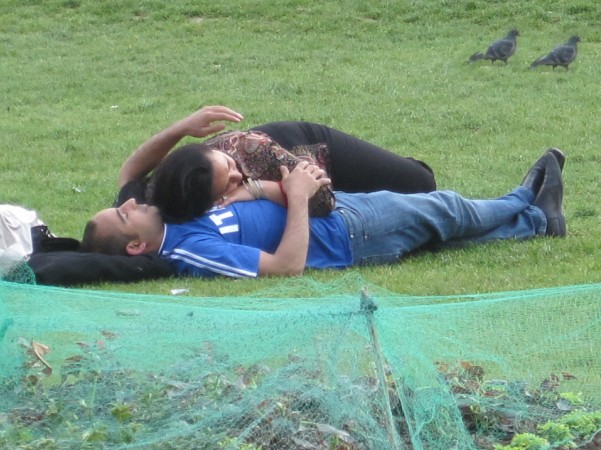 |
I
counted well over a dozen different couples in various degrees of
embrace similar to the photographs.
I would have
snapped more pictures, but I respected their privacy too
much to let them notice they were being watched.
As far as I was
concerned, this vast outpouring of affection was all the
proof I needed to conclude
Paris had
definitely lived up to its reputation as the
most romantic city in the world.
My only regret
is forgetting to take a picture of Marla and I smooching
with the Eiffel Tower in the background.
To be honest,
when I returned to Marla's side, I was more than ready to
give my wife a kiss and a big hug, but to be honest, I could
see she didn't feel very good. I decided to save our
kiss for the next visit to Paris.
Now I was
curious "how" Paris had developed such an enviable
reputation.
The second part of my
story reveals what I discovered.
Romance in Paris
|
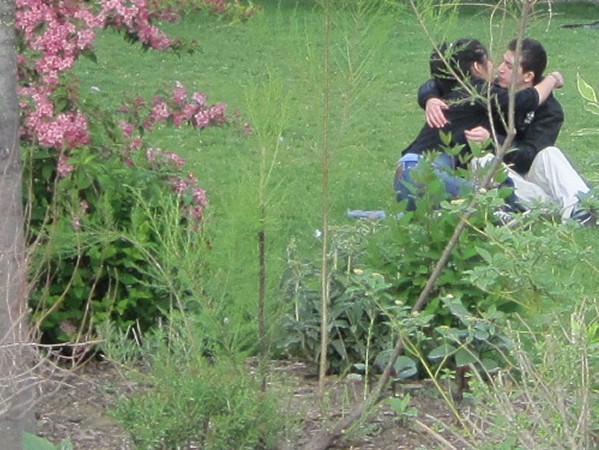 |
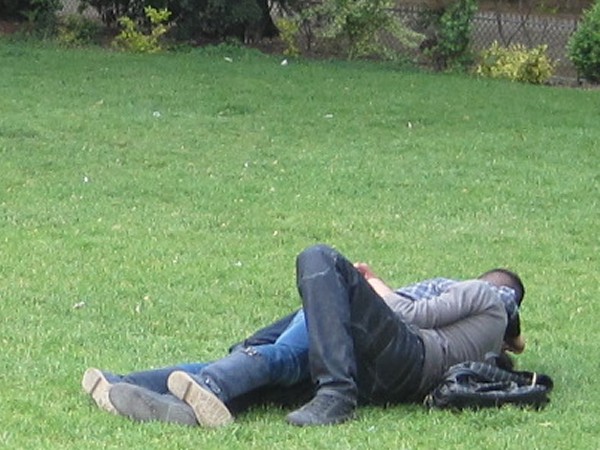 |
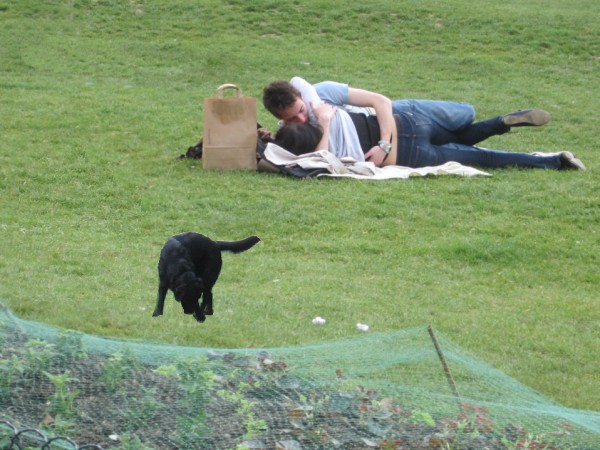 |
|